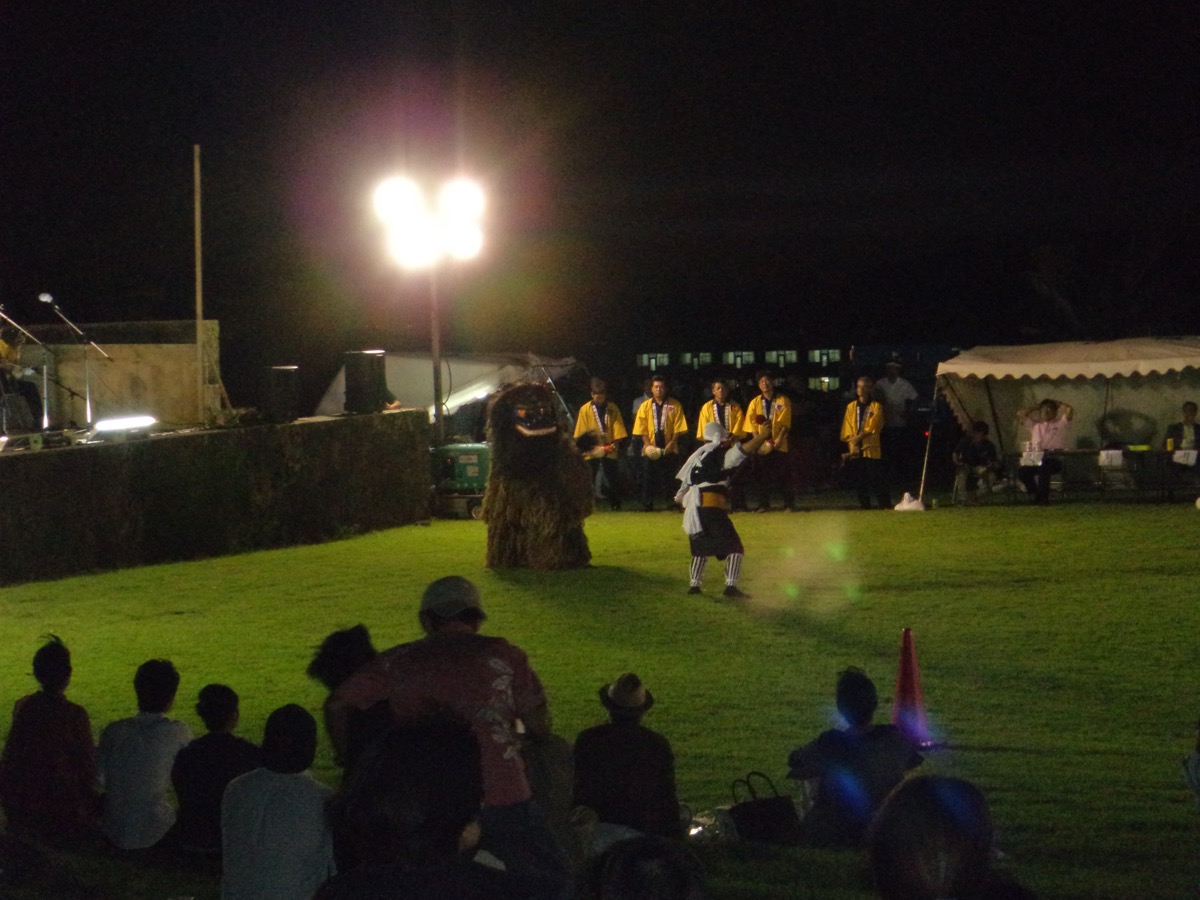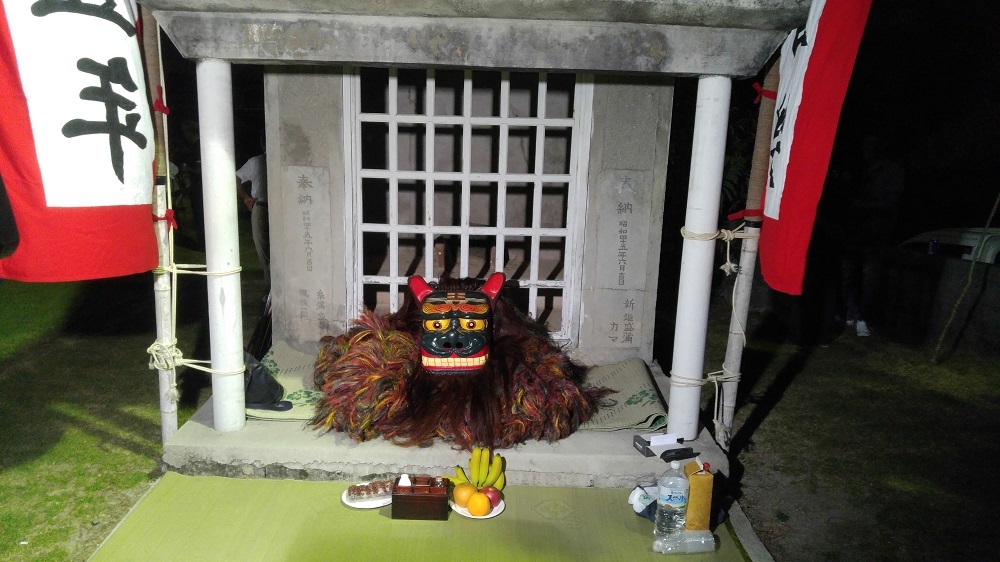いい そーぐゎち でーびる
ii sougwachi debiru
In Japanese, this is more equivalent to 良い正月で御座います (yoi shougatsu de gozaimasu), rather than 明けましておめでとう御座います (akemashite omedetou gozaimasu).
そーぐゎち sougwachi is 正月 shogatsu in Japanese, New Year in English.
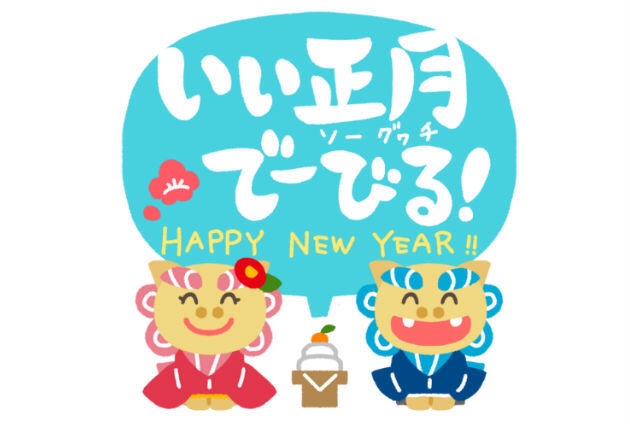
A slice of Okinawa: Eating, Living, Traveling as a foreign student in Okinawa, Japan.
いい そーぐゎち でーびる
ii sougwachi debiru
In Japanese, this is more equivalent to 良い正月で御座います (yoi shougatsu de gozaimasu), rather than 明けましておめでとう御座います (akemashite omedetou gozaimasu).
そーぐゎち sougwachi is 正月 shogatsu in Japanese, New Year in English.

うちなー uchinaa: belonging to Okinawa
Okinawa has created some “special days” in the calendar to celebrate different aspects of Okinawa/Ryukyu culture and industry. Based on the sounds of the words or some other special meaning, they choose a day in the calendar to represent it. Please keep in mind these are not serious holidays, just “fun” holidays.
Here is a list of some of them (they sometimes add new ones and probably I have forgotten a few); I will slowly be adding descriptions for each day:
February 6: taanmu ターンム (田芋), English: taro
February 22: Yaeyama kamaboko 八重山かまぼこ, fishcake from the Yaeyama islands
March 4: sanshin 三線, traditional Okinawa 3-string instrument
March 5: sango サンゴ, English: coral
March 8: sanba 三板, traditional wooden Okinawa percussive instrument
March 14: sata andagi サーターアンダギー, Okinawa donut
*March 2 LUNAR CALENDAR: sannin サンニン (月桃), English: shell ginger
April 3: shisa シーサー, guardian lion-dogs
April 10: shibui シブイ, English: winter melon
April 15: mozuku もずく, a type of seaweed popular in Okinawa
Fourth Sunday in April: satoukibi さとうきび, English: sugarcane
May 4: minsa みんさー, type of Okinawa weaving pattern. A traditional minsa pattern consists of four and five small rectangles. These rectangles represent eternal love.
May 8: goya ゴーヤー, English: bitter melon
May 10: kokutou 黒糖, English: brown sugar
May 12: acerola アセロラ
May 30: Lord Gosamaru 護佐丸, a famous Ryukyu Lord of Nakagusuku
July 8: Naha 那覇, major city of Okinawa main island
July 10: Ultraman ウルトラマン, famous super-fighter character who comes from Okinawa
July 15: mango マンゴー
October 17: soba そば (suba すば)
October 25: karate 空手
November 1: awamori 泡盛, local Okinawa liquor
December 23: umibudou 海ぶどう, sea grapes
*after each word comes の日 (-no-hi), meaning “__ day.”
Example: “goya-no-hi” is “goya day”
節分: Setsubun
祭: festival
In a previous post, I talked a little about Setsubun, the bean-scattering ceremony. This year, I went to the setsubun-sai (festival) at Naminoue Shrine, which is held on February 3rd. It was a grey and cloudy day, with a bit of a chill. My husband and I parked the car a few blocks away from the shrine and stopped at a conbini for coffee.
We walked up to the shrine a bit before 10am (the starting time), and with the overcast weather, it was busy but not as busy as New Years hatsumode. It started promptly at 10am, with some prayers and rites of various sorts. Next came the shishimai (lion dance), which is always a lot of fun. Finally it was time for the bean-throwing!
Now what surprised me about this festival was that they didn’t just throw beans… they threw oranges, candies, and little bags of snacks/toy as well! It was crazy, but entertaining. Again, like the Naritasan fukusenji festival, some people had bags and baskets, or used their hats, to help catch the flying prizes. After everything was thrown, the local news interviewed kids to see what all they caught. They also handed out hot zenzai (sweet red bean soup) at the shrine window~~ so as soon as the throwing is done, get in line before they run out of zenzai!
Overall, it was a lot of fun and not as crowded as I feared. So if you are in Okinawa during Setsubun, be sure to check out Naminoue Shrine’s festival!
You can also wait until Feb 11th (public holiday in Japan) for Naritasan Fukusenji’s bean-throwing festival. Since Naritasan fukusenji is my local temple, I typically attend the events there; this setsubun festival is a lot of fun too, though not as big as Naminoue shrine’s, and they only throw beans at this one. Plus at Naritasan, the sakura are usually blooming well, so the temple looks very pretty this time of year.
Narita-san Fukusenji (temple) holds their festival on Feb 11th, 2pm: 〒901-2403 沖縄県中頭郡中城村字伊舎堂617 https://goo.gl/maps/r1YFXQDMQVE2
Naminoue Shrine 波上宮 in Naha has a large Setsubun festival held on Feb 3rd, 10am, every year; it is shown on the news: https://goo.gl/maps/sLP2LHodzT92
Gokokuji Shrine 護国神社 also has a Setsubun festival, Feb 3rd, 9am: https://goo.gl/maps/KayHk5KVwWo
osechi-ryouri 御節料理: New Year’s cuisine
Previously I posted some basic info about New Year’s celebrations in Okinawa. But this is all about the food, so let’s talk food.
The grocery aisles are lined with various important foods on display, many of which may not be too familiar to foreigners.
In this modern day you will see stores bustling with pre-orders, as not many people have so much time to prepare all these foods! Again, it usually falls on the wife of the oldest son to prepare these things, so as you can imagine ordering a platter with all the required items from a restaurant or grocery store is much easier than making everything yourself.
There are a some traditional foods necessary for Okinawan osechi-ryouri, and it is typically the same items you see in usanmi (feast boxes), so click on the post to learn a little more about these foods. Honestly in the stores, the fried foods and Okinawa hors d’oeuvres plates (オードブル) were flying off the shelves while the mainland-style foods were left somewhat untouched.
Some items in the aisles are traditional Japanese, while others are traditional Okinawan; here are a few of the things you may see: (I have more to add to this list, but here it is for now).
Oranges/mikan みかん (also called daidai 橙): you will see bags and bags of oranges for sale, these are an important symbol for New Year, meaning “generation to generation.” These are put on the altar, eaten, even attached to a shimenawa (rope wreath made from rice straw).
Beans 豆: I wrote a post on beans already… basically beans are good luck, ward of evil… all sorts of things really. Often the store sell different types of sweetened beans (particularly kuromame, black beans 黒豆), ready made in the refrigerator section for eating.
kuri kinton 栗きんとん: sweet chestnut mash with sweet potato. It symbolizes fortune and wealth.
kamaboko (fishcake) かまぼこ: usually seen in kouhaku 紅白 (red/pink and white colors), as well as fancy designs, or even shaped like Mt Fuji. Traditionally, slices of kamaboko are in rows or arranged in a pattern. The color and shape are reminiscent of Japan rising sun, and have a celebratory, festive meaning.
konbu 昆布: a kind of seaweed, usually tied in knots. It is associated with the word yorokobu, meaning “joy.”
datemaki (伊達巻): cooked sweet egg and hanpen (fishcake) rolled into an omelet; it has a ribbed outer surface like the sun. In Okinawa, something called castella kamaboko カステラかまぼこ, fishcake “cake” is also very popular. It is similar to “datemaki,” though datemaki is usually a more rolled shape where you can see layers. This is yellow with minced fish and eggs, resembling more of a castella sponge cake.
sardines/tazukuri (田作り): dried sardines cooked in shoyu; the fish were used historically to fertilize rice fields. It symbolizes an abundant harvest.
ebi 海老 (shrimp): hunched like an elder, so it represents a long life.
mochi/wagashi sweets: often you will see sweets in fortuitous shapes or in the shape of the upcoming year’s zodiac.
Another “favorite” here in Okinawa is nakamijiru 中身汁, intestines soup (pork). This is a very traditional dish for Okinawan people, but younger generations are (for perhaps obvious reasons) less inclined to eat it these days. Bags of pre-made soup (just heat and serve) and large bags of “chitlins” (pieces of intestines, pardon the American slang) are easily found in the center aisles of the store this time of year.
As mentioned before about toshikoshi soba 年越しそば (year-end soba, or year-crossing soba), buckwheat noodles are not very common in Okinawa. Rather, many people may eat Okinawa soba instead. So you may also see many rows of Okinawa soba noodles, broth, and pork prominently displayed in aisles under New Year signs.
大晦日 oomisoka: New Year’s eve
**in Okinawa language it is pronounced “toushinuyuruu” とぅしぬゆるー
New year’s eve in Okinawa is a bit different from the mainland. Overall, there are less temples and shrines in Okinawa than in the mainland (not only, this but historically there are some differences in religion), so visiting at the stroke of midnight is not nearly as common. Some people do it, but it is much less of a thing here than mainland Japan. Mostly only the big ones like Naminoue Shrine in Naha, or Futenma Shrine in Ginowan, are crowded. I have a list of some temples and shrines in Okinawa in a previous post, as well as a description of hatsumode. I described some of the Okinawa New Year’s customs in another post.
As far as countdown fireworks, there are some, mostly at the resort areas. Again, mostly for tourists rather than the common folk, these shows are only about 1 minute; typically the resorts also host live music shows or dance parties as well. Outside of the resorts, Itoman Peaceful illuminations by the Peace Memorial Park and the ChuraSun Beach illuminations in Tomigusuku have fireworks. There are also some fireworks by the Nakagusuku Port/Awase area (by the Comprehensive Park) that I can see from my lanai, and then some to the south in Nanjo at the Yuinchi Wellness resort that I can see as well. The Peace Memorial Park has some solemn ceremony as well, to pray for a peaceful New Year.
Many people stay at home for New Year’s eve. Young people, Americans, and tourists often go out to all-night events, so some areas around Naha, American bases and resorts hold various types of music and party events.
In terms of food, year-end (or year-crossing) soba 年越しそば (toshikoshi soba) takes the form of traditional Okinawa soba rather than mainland style buckwheat soba. Although toshikoshi soba is not that popular here, you will find that the Japanese soba and Okinawa suba places are very busy on New Year’s eve anyway. Rather, typical celebratory foods also used in other Ryukyu feast days are more common. So those feast boxes, usanmi ウサンミ, are the typical; you can buy them at any grocery store during this time, though it is better to pre-order. In addition to usanmi, hors d’oeuvres オードブル trays are commonly purchased (or pre-ordered) from grocery stores and restaurants. But don’t let the name fool you, it is not what many westerners may consider hors d’oeuvres… but rather lots of fried foods and meats. In Hawai’i it is similar to the idea of “heavy pupus.”
Red vs White (Kouhaku uta Gassen 紅白歌合戦) is one of the New Year’s eve TV programs that I am familiar with; there are others, but this is the tradition for my husband and I. Probably because Arashi 嵐 (boy band of my generation) has hosted it a few times, I insist on watching it. This year, Okinawa’s own Namie Amuro 安室奈美恵 will be singing.
Anyway, there are different options on how to spend the eve of the New Year in Okinawa… choose what you like best.
*I will try to add a little more info to this post with some more traditional customs over the next week or so.
文化 bunka: culture
文化の日 bunka-no-hi: Culture Day
In Japan, on November 3rd is “Culture Day,” a national public holiday.
In our village, there was a culture celebration held the following weekend. Various village products were promoted, and people did various types of performances at the local auditorium. Not just our village, many many surrounding towns and villages also held culture festivities similar to this one the same weekend, so if you live in Okinawa be sure to seek them out this time of year.
We did not go see all of them (the program was several hours long), but we did go see the final act, a kumiodori 組踊 (traditional Ryukyu musical play/dance) put on by the local village people. The piece they enacted was the age old story of Lord Gosamaru 護佐丸; Lord Amawari’s betrayal, Lord Gosamaru’s suicide, and his son’s revenge. The performance is in uchinaaguchi うちなーぐち (Okinawan language), so it is a little difficult to understand all the dialog/singing. But it was fun and interesting nonetheless. Another chance to immerse ourselves in local culture and get to know our neighbors.
We also ate little taiyaki たい焼き in the shape of Gosamaru before the performance, sold at one of the small stands as part of the culture celebration.
If you are in Okinawa during Obon, then likely you will hear eisa drums in the distance. I previously wrote a tiny bit introducing about Okinawa’s bon dance, eisa エイサー, in another post. You can hear eisa pretty much year-round, and especially at summer matsuri (~July-October), but it is most important during Obon. Neighborhood Obon eisa can occur anytime in the 4 day interval from the first evening (unkeh ウンケー) usually until the day after last day (uukui ウークイ). The act of eisa parading around the neighborhood is called 道じゅねー “Michi Junee.”
So I know many people just keep their windows open and listen for the sounds of eisa, following it when they hear it. But, honestly there is a better way to find out when and where they will be performing near you… there are likely signs in your neighborhood, though if you don’t read Japanese, you might not realize that is what they are for. I have passed dozens upon dozens of simple painted wooden signs indicating when eisa will be performed for various neighborhoods, so just keep your eyes out; occasionally you will get some modernizing areas post it on the official village/town/city website or even on a Facebook page. So what do these signs looks like?
key words that you might see on signs:
旧盆 kyuubon お盆 obon エイサー eisa 盆踊り bon odori/bon dance ウンケー unkeh, the first day of obon 中日 nakanuhi, the 2nd day of obon ウークイ uukui, the 3rd day of obon 月 month 日 day 時 hour 場所 place/location 区 ward/neighborhood 公民館 public hall 広場 open space/wide space
ウサンミ (kanji: 御三味): usanmi.
Usanmi are Okinawan feasts typically prepared during holidays such as shiimii 清明祭 and Obon 旧盆. It is packed into lacquered multi-tiered boxes. The amount of food should be in odd numbers, usually 9. Usanmi seems to be a mixed custom, with origins in China and with Japanese influence… after all, Okinawa is a “chanpuru culture” (mixed culture).
These foods are nearly always some combination of the following, I have noted 7 items which are required, and the other 2 depend on family/region (I will slowly add pictures of each of these):
castella kamaboko カステラかまぼこ: fishcake “cake”; it is similar to “datemaki,” though datemaki is usually a more rolled shape where you can see layers. It is yellow with minced fish and eggs, resembling a castella sponge cake. Optional.
kouhaku kamaboko 紅白かまぼこ: red and white fishcake. Required!
age-doufu 揚げ豆腐: fried tofu. Required!
tenpura 天ぷら: various fried things, such as shrimp, squid, fish. Required.
konbu 昆布: kelp, boiled and tied into knots. Required
gobou ごぼう: burdock root, cut into long sticks and boiled in a broth. Required.
konnyaku こんにゃく: konjac, turned into a twisted shape and boiled. Required.
sanmainiku 豚三枚肉: boiled pork meat ribs, usually cheap and popular with Okinawans. Required.
taimo (tanmu) 田芋: taro, usually fried. Optional.
daikon nitsuke 大根煮付: boiled daikon (radish). Optional.
mochi 餅: usually just plain white rice cake is used for offerings, though if it is for eating there will usually be red bean paste (anko) inside. Mochi are put into a SEPARATE box, and not mixed with the others. This second box is required!
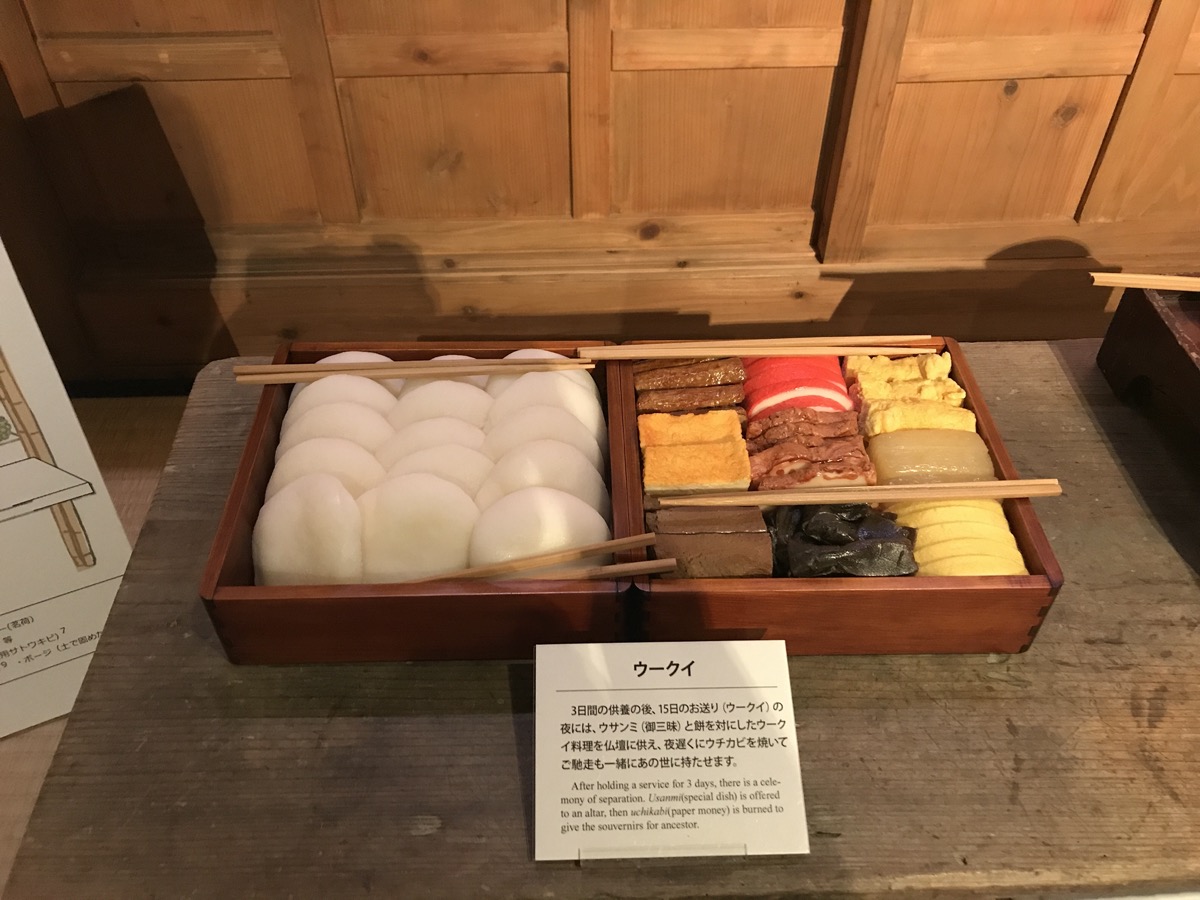
I read some recipes on how to make all of these… at some point I shall put them up for those interested in challenging to make this and become and Okinawa cuisine master.
To be traditional, you should use umeshi (special Okinawa chopsticks) to eat it.
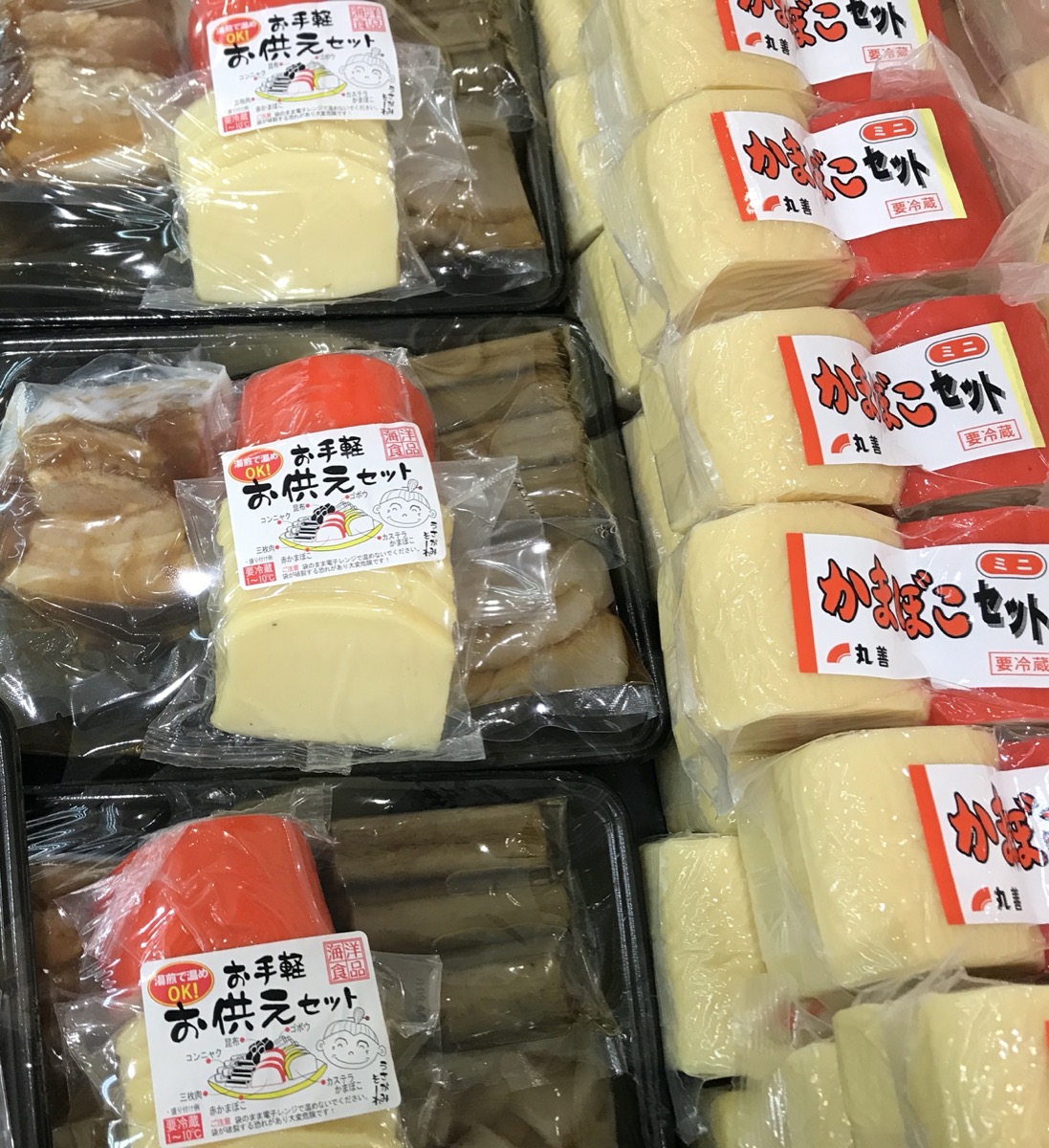
七夕 Tanabata: Japanese Star festival on July 7th (read more here).
そうめん (素麺) somen: a type of noodles made of wheat flour so they are white and very thin. It is a very popular dish during summer.
I wrote previously about Tanabata and how it is not really celebrated the same in Okinawa. But with ever-changing populations, you see a little more each year.
A traditional food for Tanabata is… somen! Not only is it perfect as a summer dish, but the noodles represent the Milky way and Orihime’s threads (she was a weaver).
This type of somen dish is served chilled with a a tsuyu つゆ dipping sauce (mix of shoyu and dashi). If you want to be fancy, you can slice up okra and serve on top (they look like cute little stars). Or you could cut other veggies into star shapes, but that sounds like too much work for me, although there are many Japanese kitchen gadgets used for bento to aid with this. Perhaps you could even find those cucumbers grown into star shapes here in Japan.
Some places in Okinawa will have a nagashi-somen 流しそうめん event (translation: flowing noodles) around this time of year. A bamboo “slide” is set up and you grab them as they go buy with your hashi 箸 (chopsticks). It’s a lot of fun, so I recommend trying it.
(photos coming soon).
慰霊の日 irei-no-hi: Okinawa War Memorial Day.
Irei-no-hi is on June 23rd. This is a prefectural holiday here in Okinawa, so schools and government offices close. It is a day to remember and pray for those Okinawans whose lives were sacrificed during the Battle of Okinawa and WWII, especially since the majority of them were civilians, not soldiers, and so much of the island was destroyed by the ravages of battle.
Many museums and art galleries have special displays, usually photography, during this time. The Peace Park in Itoman has a special remembrance ceremony, light-up, and lantern floating with messages of peace on this day. The news programs all dedicate a lot of time to memorials this day.
If you want to visit the Itoman Peace Memorial Park during this time, you will need to take a shuttle, as parking is limited. It is a more somber event, but worthwhile nonetheless.
金沢 Kanazawa is located in Ishikawa prefecture 石川県.
百万石祭 Hyakumangoku Matsuri: The Hyakumangoku Festival is held in commemoration of Lord Maeda Toshiie’s entry into Kanazawa castle on 14th June, 1583 (Tensho 11) which laid the foundations of the present day Kanazawa.
Summer is approaching, and we decided to take a trip up to Kanazawa for the matsuri since my mother-in-law came to Okinawa to visit us.
We flew into Komatsu Airport on Friday and from there took the bus (~45 min) to Kanazawa Station. Since there were 3 of us, we booked an AirBnb near the castle park.
Once we were settled in, we decided to check out the town. We walked towards the castle area and Kenrokuen 兼六園 (one of Japan’s top 3 beautiful gardens) where there were many museums. We looked through some ceramics shops and also ended up at the 21st Century Modern Art museum. It was fairly interesting, though no pictures inside except in the “pool” area. Overall, it was quite a nice area. Kanazawa has many beautiful traditional Japanese crafts, such as ceramics, lacquerware, cloths, as well as items adorned in gold leaf. We enjoyed seeing all of these in shops and museums.
Since the festival was starting up, there were food stalls everywhere, all with mostly typical matsuri food (yakisoba, grilled squid, takoyaki, bananas on sticks, yakitori, etc).
On Friday evening, there was the Kaga Yuzen Toro-Nagashi 加賀友禅燈ろう流し (Lantern floating ceremony). It was definitely packed with people, and I am not sure we were in the best spot by the Ashinogawa bridge, but we still got to see plenty. Since it was dark at this point it was actually very chilly considering it was the first week in June, and I did not pack appropriately. I don’t know if this was unseasonably chilly, but I would recommend pants/long sleeves/jacket/light sweater type of clothes if you go. While the lanterns were floating down the river, children’s parades were going on throughout the town. It was quite cute with them dressed up, carrying lanterns, and playing drums.
The next morning (Saturday), we wandered about the old samurai districts and went through the Nomura Family Samurai House. I stopped at every opportunity I could to look at and taste Japanese sweets (unfortunately husband and MIL are a lot less interested in these as I am).
We wound our way down to Kenrokuen (garden) which was free that day. We spent some time enjoying the beautiful grounds and buildings within the park itself. Next, we went to a tea ceremony held inside the park. I was a bit expensive (1500yen), but interesting (and delicious) for me (again, less so for husband and MIL). So perhaps I would not recommend it unless you are interested in these things.
After the park, we went over to the castle and walked all the way through. Various performances were being held in the open field for the matsuri… some traditional, some less so. There was traditional shishimai 獅子舞 (lion dance), which was different than Okinawan-style– it was so interesting! The castle was nice, though maybe not as nice as some of the other castles in Japan.
Higashi chaya-gai ひがし茶屋街, the old entertainment (geisha) district, was my next stop. I stopped at several traditional Japanese confectionaries (wagashi-ya 和菓子屋), for samples and shopping. They were are marvelous and varied. Many sweets included gold-leaf topping which Kanazawa is known for– over 98% of Japan’s gold leaf is produced here. I saw many people consuming gold leaf ice cream. Some shop keepers may speak English, but it is much easier to communicate in Japanese. There was a shop with local nihonshu 日本酒 where you could order a glass (average price 500yen) and drink; this place was filled more with young’uns who were mostly interested in getting a little tipsy, and there was not a lot of room (some people even just ordered regular beer). I simply ordered the recommended-of-the-day 本日のおすすめ, which ended up to be so-so. Next time I might skip this place unless it was less crowded. I could have stayed in this area for hours admiring all the sweet goodies, but my fellow travelers were not as enthusiastic about this. While this place was a bit touristy in some regards, it was interesting and fun for wagashi-lover like myself. During certain times of year, I hear it is possible to go to geisha shows/dinner.
In the afternoon was the main parade. We were recommended to watch closer to the park grounds than the main station where it started. It seemed to work out nicely. The first part of the parade was mostly just some local groups, but towards the middle and end was the traditional dancing, costumes, music, princesses, etc. So next time I would probably skip the first hour and just watch the last half to be honest!
We had reservations for dinner to Kotobukiya for shojin ryori 精進料理 (Buddhist vegetarian cuisine) at a ryotei 料亭 (a type of traditional Japanese restaurant). It was really quite nice, though also quite expensive. Course after course came in, and my husband and I drank nihonshu 日本酒 with it. Afterwards we were quite exhausted and all went back to the Airbnb to crash. I would have liked to go watch some of the Noh theater, but it was chilly and everyone, including myself, was tired from a long day. Maybe next time.
Sunday morning, we walked through Nishi chaya-gai にし茶屋街 old entertainment district, looping through the Temple district. The Nishi chaya-gai was much smaller than its counterpart, yet still very beautiful. Since we went early in the morning, nothing was open yet, though the children’s matsuri was getting ready for their activities in the Temple district (where we actually headed next). There are so many old temples clustered together, including the “ninja temple” (which I did not get reservations for). It makes for an interesting walk. The ninja temple requires reservations, and the tour is in Japanese. However, you can walk about the outside part, even if you cannot go in and see all the ninja traps.
Finally, after omiyage and eki-bento shopping at Kanazawa Station, we boarded the train to Tokyo for a 2.5 hour journey. Of course, I purchased some local Kanazawa beers for the train ride…
Overall, we had a wonderful and interesting time in Kanazawa known as “little Kyoto”!
Images: https://imgur.com/a/mYY0t
On the 5th month 4th day of the lunar year is a day known as yukkanuhi ユッカヌヒー, meaning “4th day” in Okinawan language. It is to pray for good luck in fishing and maritime activities and a celebration day with traditional haarii ハーリー (dragon boat) races. This usually close to the end of the rainy season here in Okinawa. This year (2017) it will be Monday May 29th. Although I am supposed to go to work that day, I would really like to go watch the haarii…
On the 5th day of the 5th month, known as gungwachi gunichi グングヮチグニチ (五月五日, meaning “5th month 5th day” in Okinawan language), is Boy’s Day, also known as Children’s Day in the Japanese calendar (orginally “tengu no sekku” 端午の節句).
It is traditional to serve popo ぽーぽー and chinpin ちんぴん on these 2 days; it is also placed on the ancestors altar or the hinukan as an offering to pray for good health and prosperity of boys/children/family, as well as for ocean safety and good catches for fishermen.
It is also traditional to place irises (shoubu 菖蒲) and another type of sweet dish called amagashi アマガシ (or あまがし) on the altar or hinukan during these days in Okinawa.
Amagashi is sort of like a mix between amazake 甘酒 and zenzai ぜんざい; red beans mixed with rolled oats (wheat or barley), mung beans, rice koji, and brown sugar (it ferments for 2-3 days after making it). It used to be eaten with the leaves of the irises, but I have my doubts that it is common any more. It is possible to find pre-made in the local grocery stores, next to the zenzai cans and packages. It can be made with either Japanese azuki beans or red kidney beans, though the red kidney beans are actually more common due to the American influence after WW2, making them cheap and accessible.
弥勒: Miroku (Japanese). In Okinawan language it is pronounced “Miruku.” It feels kind of strange, because ミルク miruku is one way to say “milk” in Japanese as well. But in this case, miruku ミルク is a deity 神様 (kami-sama), not the white beverage!
*神 kami means “god,” and -様 -sama is a very polite way to address people in Japanese.
Used as ミルク神, it should probably be pronounced miruku-shin, though I sometimes see variations such as miruku-gami and miruku-kami.
Miruku is actually one of the most commonly worshipped gods in the Ryukyu islands, especially the Yaeyama islands. Often someone will dress as Miruku in the island festivals, a long yellow robe with a large white mask carrying a fan. He is believed to have come from across the sea, nirai kanai ニライカナイ (this means sort of like “heaven” to Okinawan people), and comes bringing good fortune.
Hateruma 波照間島, the southern most island, is famous for “Mushaama,” a festival during the obon. The festival is designated as a National Important Intangible Folk Cultural Property, and held on July 14th of the lunar calendar. It combines obon festivities with harvest ceremonies like the Miruku fertility deity parade and shishimai (lion dance). Islanders offer prayers to their ancestors and pray for their happiness, bountiful crops and of course, a big catch at sea.
In Akata 赤田 of Shuri, a traditional ceremony called miruku unke みるくウンケー is held. A smiling maitreya (a bodhisattva) and his followers walk around the community and pray for the good health and prosperity of residents. The miruku unke ceremony was revived in 1994 after not being held for about sixty years! Since then it has become an annual event. Starting from the Akata Club Community Center, the miruku walks at the head of the parade, called suneei スネーイ. About 100 people follow, including a marching band and children carrying flags of the Ryukyu era (these particular flags are called ンカジ, nkaji, which means “centipede” in Okinawa language, due to their jagged edges), while the miruku waves his paper fan to drive off evil spirits from around the people waiting to watch the parade. Often babies cry (I guess he is a little scary) and elderly people wave from the second floor of their houses. The parade is called suneei スネーイ. It typically happens on the Sunday before Obon. In 2018 this will be August 19th; in previous years it has begun around 4:30pm. In some other villages, the miruku parades occur on different days.
If you live in Okinawa, you should definitely go watch one of these parades with Miruku-kamisama!
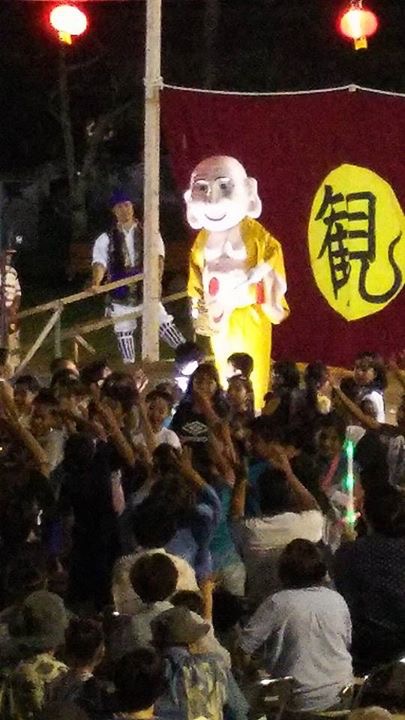
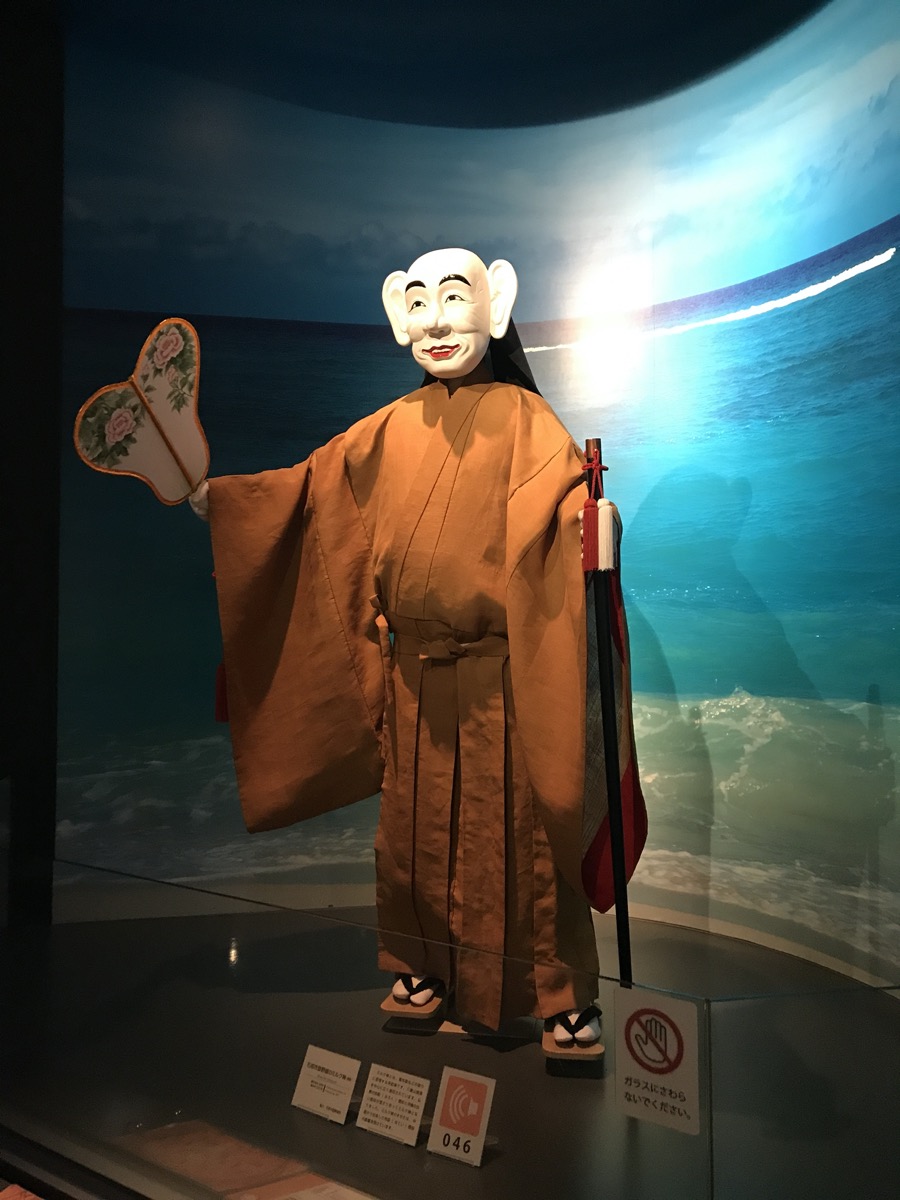
Youtube videos of Miruku in the town near me, Nishihara.
https://www.youtube.com/watch?v=HP_J4FBcAwE
こどもの日 kodomo-no-hi is Children’s Day, a public holiday in Japan celebrated on May 5th. There are many events, especially for families and children going on during this time. Many places in Okinawa give free or discounted admission to various attractions, such as the aquarium, museums, the zoo, boat tours, and gardens. People will fly koinobori 鯉のぼり, carp flags, all around the towns– it is such a nice site to see. Originally it was Boys’ Day, Tango no Sekku 端午の節句, but has been changed to celebrate the happiness and health of all children. People still celebrate Boys’ Day in conjunction, though; you will see samurai armor on display, similar to seeing the doll displays during Hinamatsuri (Girls’ Day).
ちまき chimaki is a type of rice “dumpling.” This type of chimaki is a sweet and sticky rice dumpling with kudzu 葛 (arrowroot) wrapped in bamboo leaves. Chimaki is connected to Kyoto culture (it is Kyogashi 京菓子, traditional Japanese sweet made particularly in Kyoto), but originally is said to come from China. It is so fragrant and soft, so tasty! It is a popular treat for Children’s Day. I was able to find some at the Japanese confectionary at the SanA mall near me, so obviously I was tempted into buying some.
address for Japanese confectionary Hanafuu 花風: https://goo.gl/maps/8AsJs1s9Sa72
ホワイトデー is “White day” in katakana. This is like reverse Valentine’s day in Japan; guys return the favor on March 14th to the girls for the chocolates they received on February 14th. This means they give girls chocolates or small presents, like handkerchiefs or hand towels, keychains, etc.
The stores will usually just change the sign from Valentine’s day to White day on the chocolates displays. Departments stores and shops will put out displays of small presents mentioned above, usually with cute designs or packaging. It is not as big as Valentine’s day, but there are plenty of displays to remind the guys to buy the girls a small present or chocolate.
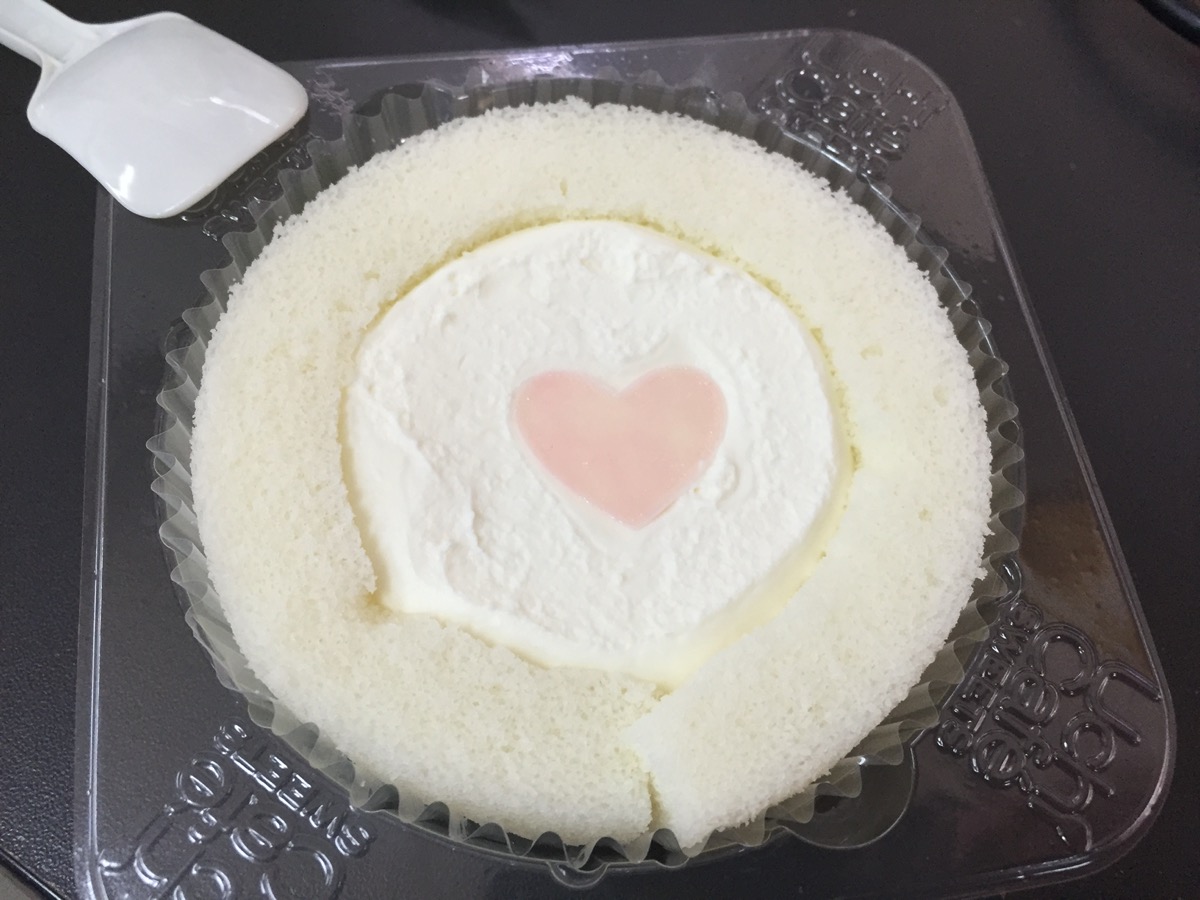
春分 shunbun is Spring equinox. It is the division of seasons.
In Okinawa, it is typically different than mainland Japan, just like shuubun 秋分 (Autumn equinox) is. While in the rest of Japan it may be more typical to visit hometowns and family graves, in Okinawa it is usually just observed at home at the butsudan (buddhist altar), with the typical special Okinawa foods used in most celebrations. The season of shiimii しーみー is just around the corner and it is the customary time to visit, clean and leave offerings at the graves then.
Spring equinox is also part of haru-no-higan 春の彼岸, which just refers to Spring equinox week. (O)higan literally means “the other shore,” meaning the other side of the river which divides the living from the deceased in the afterlife according to Buddhist tradition.
At any rate, it will be a public holiday for me, so I can hopefully enjoy the day off. And likely my sensei will bring in the leftover treats from his family’s celebration.
The third day of the third month in the lunar calendar is Okinawa’s tradition that occurs on hinamatsuri in the lunar calendar (March 3rd). It is called 浜下り, pronounced hama uri ハマウリ (in Japanese these would be hama ori). 浜 hama means “beach,” and 下り uri is “to descend.” Some people may observe it on the western calendar date, but more often it is observed on lunar calendar date. **In 2017 this day will be on March 30th.
This is also associated with the event on Henza-jima, called Sangwacha (a fisherman festival). Sangwachi-gwashi (translation: March sweets) is commonly eaten by the beach.
On March 3rd of the lunar calendar, families take their girls down to the beach and get in the water to “purify” or “cleanse” them, and to pray for good health. The seawater is supposed to get rid of any bad spirits, curses, etc. Sometimes families will collect shells, harvest asa アーサー (type of seaweed) or small clams in the tidal areas, and often have a beach-side picnic. One of the ladies in my class reminisced about when she was a child, how on Hama uri her mother took her down to the beach, they would go digging for clams and then have a picnic. She explained that on this day, the tides are low, so it is easy to harvest the clams and asa.
The Legend behind Hamauri:
Long ago, a young man visited a young girl of marriageable age one evening. He was obviously a nobleman, but he didn’t speak much about himself. He spoke sweetly to the young woman and they were became lovers. When the parents found out their daughter had become pregnant, they decided to discover more about who the mysterious nobleman was since he never said where he was from. The parents told the girl to stick a needle with a long thread to the bottom of the nobleman’s kimono when he next visited.
That night as he slept, the girl did as her parents told her. The next morning they followed the thread deep into the woods, into a cave, and inside the cave a huge snake was coiled up that spoke to them. The snake said if the girl did not enter the sea to purify her body, she would bear his children– they realized he was not a man at all, but a magical snake.
When the parents returned home, they immediately took their daughter down to the ocean to purify her body in the salt water– dead baby snakes flowed out of her body! The evil snake’ magic spell was broken and the young nobleman was never to be seen again.
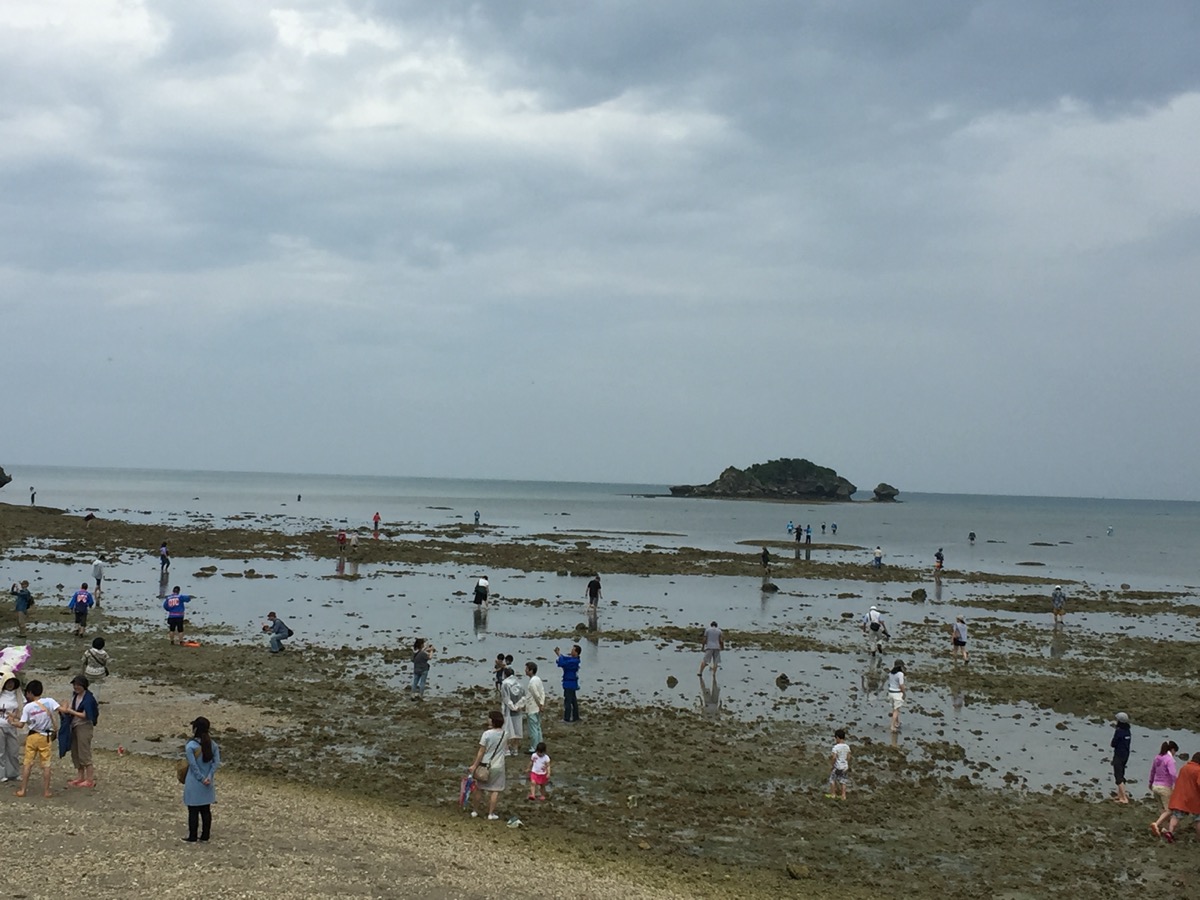
ひな祭り(or 雛祭り) hina-matsuri is translated to Girls’ Day or Doll Festival.
Hinamatsuri is on March 3rd. In Okinawa, there is a special tradition on hinamatsuri of the lunar calendar, but that will be for a different post: 浜下りhamauri.
Traditional treats and not-so-traditional treats are being sold in stores. Community centers (and maybe some homes in Okinawa) have hina doll displays. Everyone prays for the good health of girls. These doll displays are rather costly and not actually traditional in Okinawa (just mainland Japan), so not very many people here have them. But any community center, library, or department store will have a nice display to check out.
Sakura mochi 桜餅 and hishimochi 菱餅 are 2 traditional wagashi for hinamatsuri. Sakura mochi is a pink mochi wrapped in a sakura (cherry blossom leaf). Hishimochi is a 3-layered ricecake, pink, white, and green, in a diamond shape. These days, you may see other wagashi designed especially for the day, as well as cakes and western-style desserts, with cute pink designs.
Another common snack you will see is hina-arare ひなあられ, (usually pink) rice crackers.
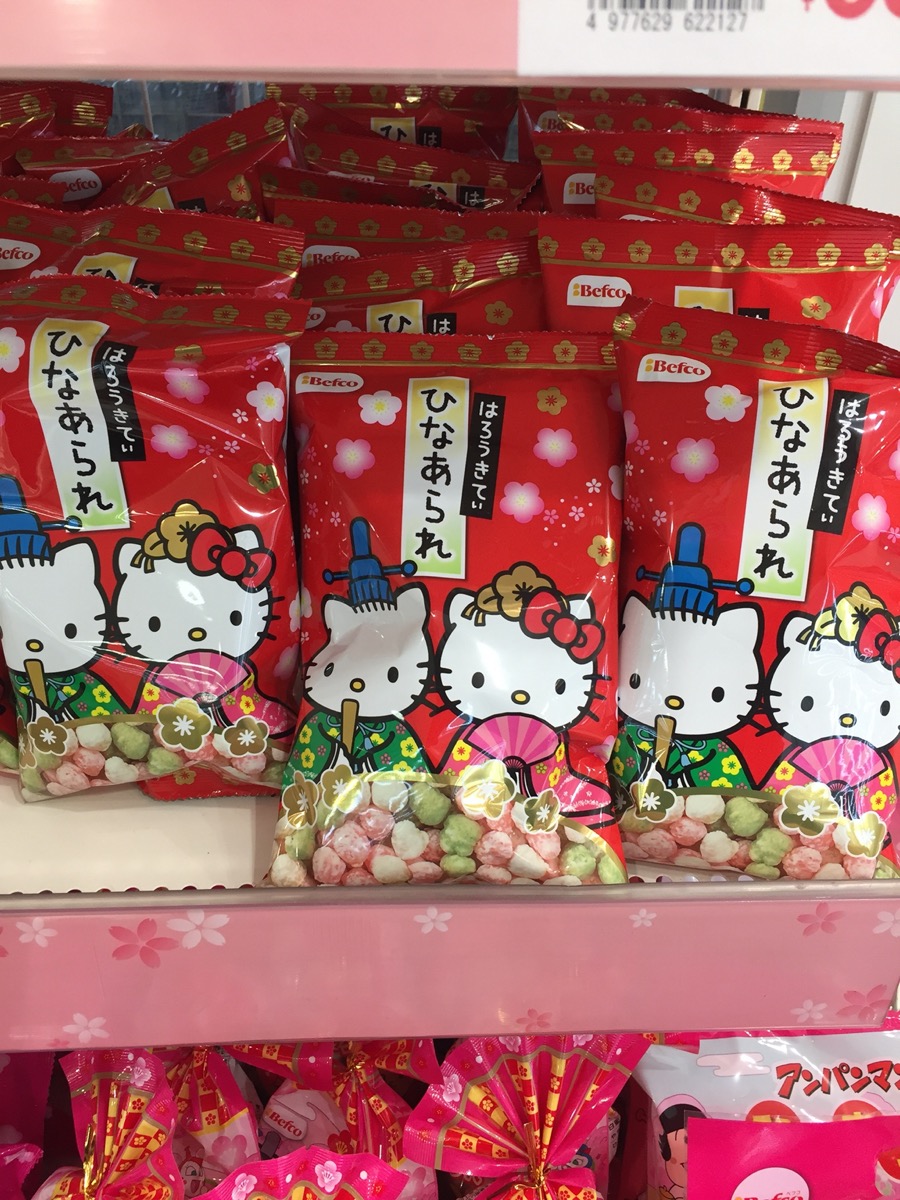
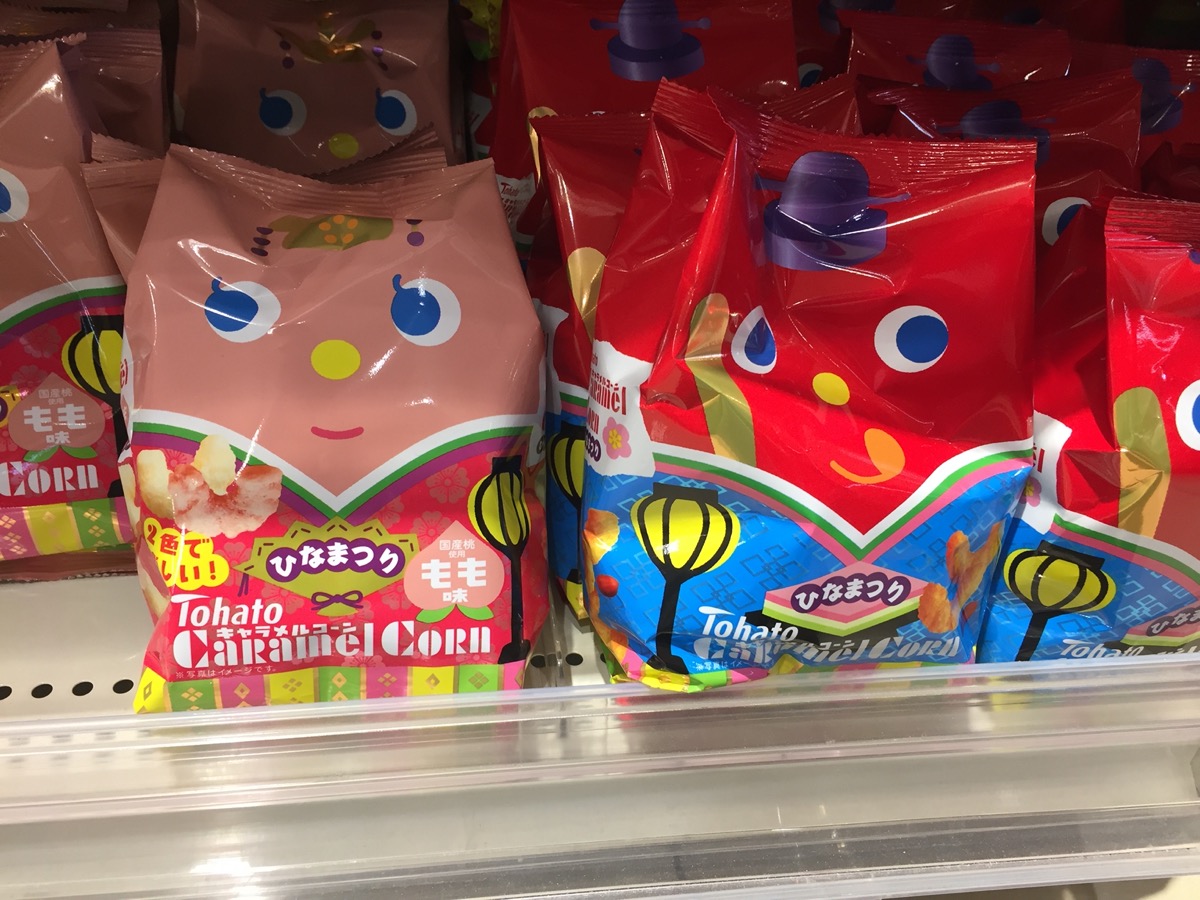
In Hawaii, Girls’ day is somewhat observed although on a much smaller scale than Japan.
Be sure to look for all these treats the next time you are in the store in Okinawa around late February and early March!
清明祭, シーミー or しーみー: shiimii (also Romanized as “shimi”) in Okinawan language. In Japanese it is pronounced Seimei-sai.
Shiimii season is will come to Okinawa around April (in the third lunar month). Even though I think you are supposed to hold the ritual around the 15th day after the Spring Equinox, most Okinawan people are on “island time” and just do it any time during the month that it is convenient for everybody to meet up or whenever the weather is good. I don’t know that there are many clear rules as to when, but generally these gathering start April 4th. I remember one of my students last year said that she was so busy during the month and was barely able to organize a small gathering at the family grave on the very last weekend of April.
It is an event to worship the ancestors, originating from China. The tombs are cleaned up and family members come together to kneel in front of the tomb, providing offerings to the ancestors and bringing along food dishes to have a small gathering/party in front of the tomb. This is one of the major observances in Ryukyuan customs, though it is mostly observed in the the central and southern areas.
Featured in the stores you will see lots of materials for packing family bento boxes, packages of mochi, fruits, items for the graves (including uchikabi, paper money, that is burned so ancestors have money in the afterlife), cleaning items, and other things necessary for a family picnic. The ads will be up soon to pre-order Okinawan-style hors d’oeuvre platters. They will look similar to the platters during New Years and Obon, with many of the same foods. These boxes are called usanmi ウサンミ.
During the month of April, you will see cars parked all along the road in Okinawa, and lots of people picnicking by the ancestor graves. I can usually tell when the season is in full swing, due to the slow traffic and the number of not-quite-legally-parked cars spilling into the main road. It is a time to remind yourself as an “outsider” to be patient, and to appreciate the preservation of culture. Usually weekends (Sundays) are the busiest days to hold these gatherings.
バレンタインデー Valentine’s day.
チョコ choco, or チョコレート chocolate.
Somehow, Valentine’s day got adopted into Japanese culture in the mid 1900s. But it is a bit different than what you see in the US. It is tradition for girls to give chocolates to men… not the other way around! Well, not until White day which is the reverse Valentine’s where guys give small presents (not necessarily chocolate) to the girls that gave them chocolates on Valentine’s day.
But not all chocolate is equal. There is honmei 本命 (true love) chocolate for the guy you like best; this is either high-end chocolate or homemade chocolate. Then there is giri 義理 chocolate, which is “obligation” chocolate that you give to guys you know (and are just friends or acquaintances with). This is usually just cute little regular chocolates. There is lately a third category, known as tomo 友 chocolate, which means “friend” chocolate. Sometimes girls may buy small chocolates for their friends (girls or guys).
In my lab, I am the only girl, so the burden sort of falls on me. I buy giri chocolate for the members in my lab. On White day, they usually buy chocolates for the whole lab in return.
Right now, the stores are lined with all types of fancy chocolates, as well as items for baking the perfect chocolate treat with cute trimmings. You can even buy some cheap stuff at the Daiso (100yen store) to really cute up your chocolates. Soon, it will all be replaced by cute girly items, some chocolates, handkerchiefs, and other small items for White day.
旧十六日祭(ジュールクニチー) “Juurukunichii” is January 16th of the Lunar calendar, which is “gusou” 後生(グソー/ グソウ) or あの世、の正月, New Years celebration for the afterlife (the dead). This means another celebration/prayer day for ancestors.
All of the stores have various small snacks for grave offerings, as well alcohol and flowers. Uchikabi (money for the dead in the afterlife) and incense is also burned on this day; the rituals are similar to that of Obon. This morning I saw some people heading out to the graves for this purpose. I suspect mostly only elder people or very traditional families still observe this old custom. I also heard from one of my Okinawan friends that it is usually families who had a death the previous year observe this custom, so perhaps not every family observes it every year.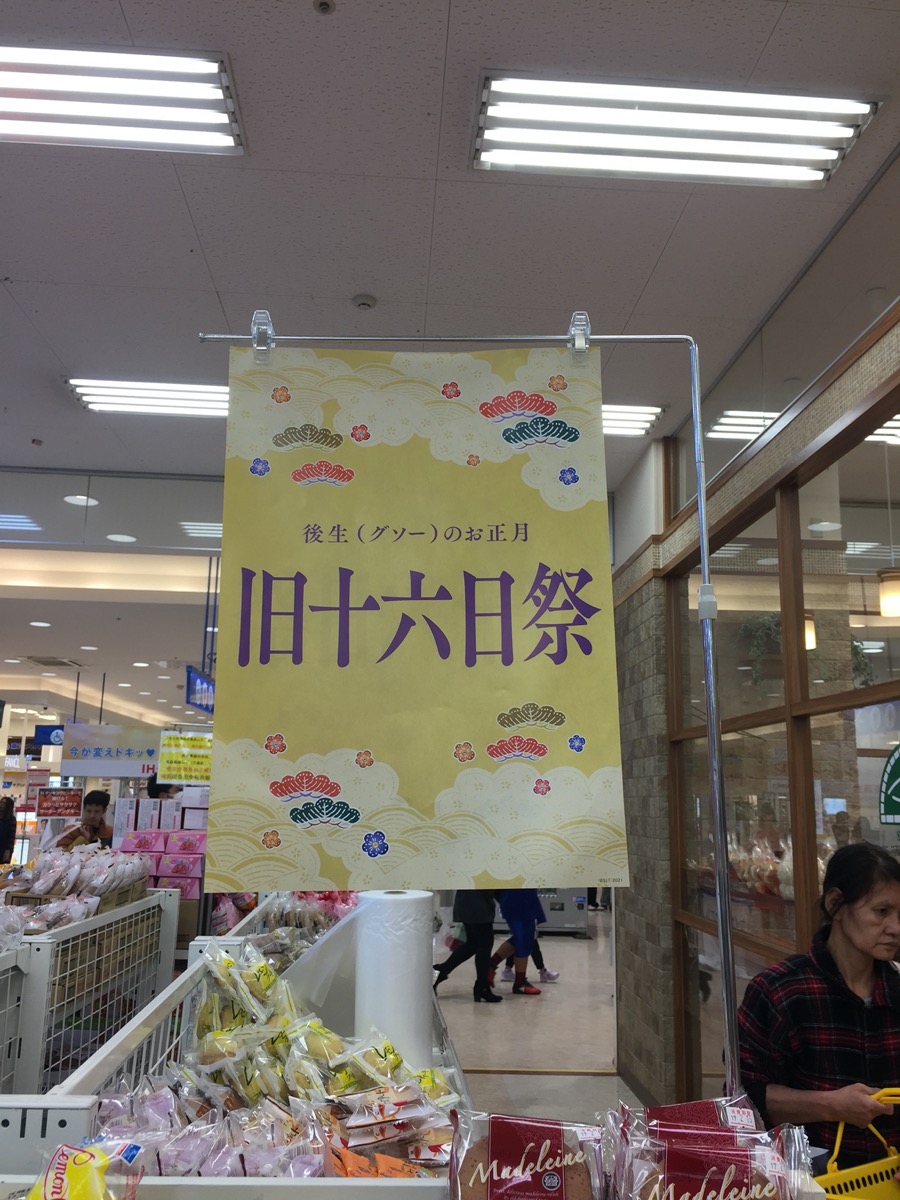
旧 kyuu: this kanji in front of the date indicates it is a lunar calendar (old calendar) date.
十 juu: ten, 六 roku (ruku in Okinawan): 6 –> so 十六 is 16.
日 nichi: day
あの世 anoyo: afterlife, the “other” world
正月 shougatsu: New Years
旧正月(ソーグヮチ、ソーグァチ、 or ソーグワチ) sougwachi, or souguwachi: lunar New Years, in Okinawan language. In Japanese, it is pronounced kyuushougatsu.
The lunar New Year was traditionally celebrated in Ryukuan culture, but these days is less common, except for a few areas where there are many fishermen, uminchu 海人(うみんちゅ). During the times of the Ryukyu Kingdom and all the way to the second World War, the lunar New Year was a big deal in Okinawa, but the end of the war brought in the Americans and with them the Gregorian calendar, so the traditions of the lunar calendar and with it the Lunar New Year has been diminishing ever since.
The lunar new year centers on towns and villages, where fishing is an important industry, such as Itoman, Uruma, Motobu and Oujima.
The most prominent location is probably Itoman, where all of the fishing boats display colorful flags to pray for good fishing and safety at sea in the upcoming year. The images of tuna and other fish are drawn as lucky symbols to attract business. Fishermen wish for good catches for the year. And nobody fishes on New Year’s day.
I went the day after the lunar New Year, so while many flags are still up, there is not much else going on and it was very quiet at the port.
There are also some worship ceremonies on Hamahiga-jima in Uruma (Hamahiga-jima is called the island of the Gods here in Okinawa). I have not been able to make it up there on the lunar New Year yet, but hopefully one of these days. These are more solemn events of prayer at the many utaki (shrines) sites (of which I believe there are at least 12), so don’t expect “festivities” per se; though at some point it does change from prayer to more festive celebrations with traditional music and dance. A yearly worshiping performed on New Year’s Day of the lunar calendar is done to wish for the health and safety of the citizens and to convey the gratitude to the gods. The nearby Miyagi-jima also has a small fisherman’s maritime parade with colorful flags that was revived a few years ago.
Here is a video from previous years:
https://www.youtube.com/watch?v=YP3kQbwmHDs
Hakugindo 白銀堂, a shrine in Itoman, fills with people wishing for a great year during New Year’s celebration period. But since no one has off of work or school, the elders say it has become a less popular tradition.
As a final note, when the first water is pumped up from a well in the early morning of January 1st of the lunar calendar, it is called “wakamizu” (meaning: young water), and when this water is drunk, there is a legend that it can pass good fortune and good health for one year.
kagami-mochi 鏡餅 is “mirror” mochi displayed in the house during New Years. You are not supposed to open it and “break” the mirror (crack the mochi into pieces) until Jan 11th (some regions might do different days, like the 15th).
I cannot tell you the number of Americans who buy one, open it, and BITE into it raw! Then they wonder why Japanese eat wax. Gross. Please do not do this.
You must heat up the dried mochi in some way: toaster oven, microwave, grill.
On kagami biraki 鏡開き (open/break the mirror ceremony), open up your dried mochi that you bought and break it into pieces (you should not use a knife but mallet or something instead, but I won’t judge you if you decide knife is easier). Inside your plastic container you will find kiri mochi 切り餅, rectangular shaped dried rice cakes. You can buy just packages of these kiri mochi in the stores as well (sometimes you can find them in round shapes as well, those usually these are labelled with maru 丸 meaning round).
My favorite way to prepare it is to toast it in the microwave or toaster oven (just a little until you see it puff up and brown), then add it to hot zenzai ぜんざい (red bean soup, you can make yourself or just buy the prepared package at SanA). Something similar is oshiruko おしるこ, which is more soup-y and smooth.
Another way would be ozoni soup お雑煮, which is usually simple dashi, mochi, plus some vegetables or fishcake.
初詣 Hatsumode: First visit to a shrine or temple in the New Year.
Every year on January 1st, I visit a temple or shrine. Here in Okinawa, I am lucky enough to have a temple within reasonable walking distance from my house, Naritasan Fukusen-ji 成田山福泉寺 (reminder, the “ji” 寺 means temple).
After a big shopping trip to pick up some fukubukuro 福袋 (lucky bags), we bundle up and climb the hill up to the temple. We walk rather than drive due to the extremely heavy amount of traffic around the temple. As we make our way up the hill, we pass a long line of cars idling on the hill, waiting to make it to the top and eventually park. We bring along old omamori お守り (amulets/protective charms) from the previous year; these are tied along the temple property (there will be be strings or ropes or posts to attach the omamori, then the monks will come through to collect them for the burning ritual). Some of the bigger shrines/temples may even have a large omamori collection bin to put them in.
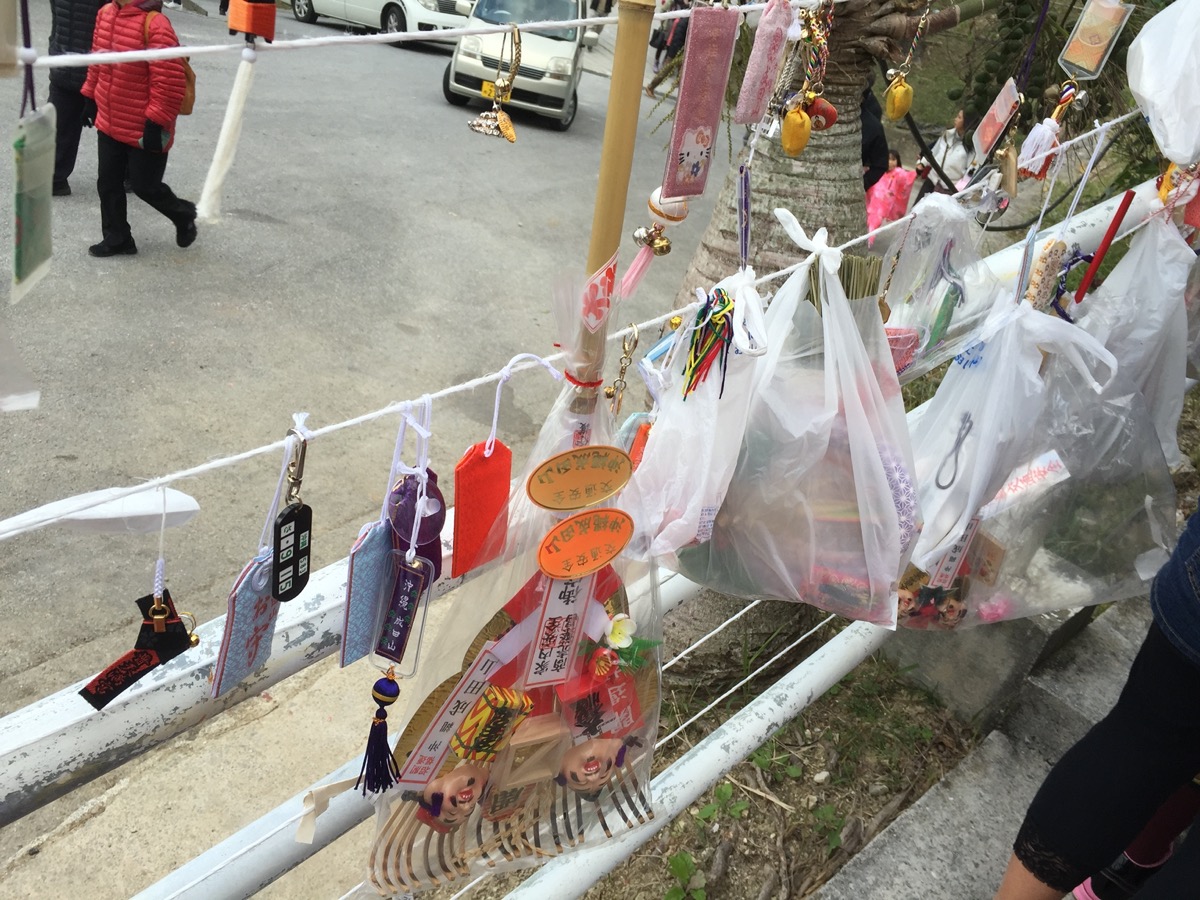
Once we finally reach the top, there are a few tents selling food and drinks. We join the end of the line to pray at the temple and purchase new omamori for the year. The line is usually quite long. At most temples, when we get close enough, we cleans ourselves at the temizuya 手水舎 (water fountain); the ritual is like a type of misogi 禊 (cleansing before entering the shrine). Remember: hold the wooden dipper in your right hand and first pour over your left, then switch and pour over your right hand, then switch again pouring a little into your left hand and use it to rinse your mouth (please don’t spit back into the basin!), and finally turn the ladle upright so the remaining water rinses over the handle. At Naritasan Fukusen-ji, there is a sign at the basin: instead of the hand/mouth cleansing you are supposed to throw water at the statue’s face 3 times for luck, so don’t be surprised to see this strange act at the temizuya!
As we approach the main worship area, we toss offerings into the box and pray for a prosperous and healthy new year. Afterwards, we head to the omamori tables and choose some assortment for the house, the car, or maybe some personal ones.
Besides omamori, it is fun to draw a fortune, omikuji おみくじ. Most temples and shrines have some in English as well as Japanese. After reading our fortune to see if we have good luck, middle luck or terrible luck, we usually tie the omikuji to a tree. I have heard both versions of tie it to a tree to leave bad luck behind, or tie it to tree to make sure it comes true. Well, whichever it is, I almost always do it no matter what.
There are a few food tents set up, so often I like to grab a dango 団子 or daifuku mochi 大福餅, and an amazake 甘酒 or hot zenzai ぜんざい.
Many places will also offer a small cup of New Year’s sake, too. At this point, most of what we have come to do at the temple is finished, and it is time to head back down the hill to home. It is a small ritual that I enjoy every year, both here in Okinawa as well as in Hawai’i.
This year I donned kimono for hatsumode; some people stared, but everyone was complimentary about it. After all, how often do you see a westerner wearing a kimono that she put on by herself? As it is in Okinawa, very few people wear kimono for hatsumode, but I wanted to go at least once to the temple in kimono.
If you cannot make it on Jan 1st, many temples and shrines in Okinawa actually stay open 24 hours, for as long as the first week in January. So don’t sweat it if you do not feel like dealing with the crazy amount of traffic the first day (or the second or third days since traffic remains heavy around these areas)… wait until a few days later and you can still participate without the crowds! On the 15th of January, we gather up our shimenawa (and other decorations as necessary) and take to the temple for burning.
Naritasan Fukusenji 成田山福泉寺 address: 〒901-2403 沖縄県中頭郡中城村字伊舎堂617
https://goo.gl/maps/dUDumjCxVUw
Some other popular temples and shrines in Okinawa to check out during the New Year:
Futenma Shrine: extremely popular; many foreigners visit this one since it is close to the American military bases.
Naminoue Shrine: probably one of the most popular to visit! Tents with foods and goods line the street as you approach the main area. It is very crowded– but pretty spectacular to see! This shrine also draws a lot of tourists, both foreign and domestic.
Kinkannonji (temple)
Okinawa Gokoku Shrine: another extremely popular shrine to visit! Again, tents with foods, games, etc line the street… it is so crowded here, and you will have to wait a bit until you can get in. But again, it is an amazing site to see, and a lot of fun. This one offered nihonshu (sake); there will be a salt box, so grab a small pinch of salt, then a cup and go for it.
Gokukuji (temple)
Awase Bijuru (shrine): This is rather small, but still crowded with locals! It is very cute, and you will probably need to wait in line a bit depending on when you go. Don’t expect much food or games here. It is a much smaller scale than the Naha shrines.
I will add a link with some uploaded pictures of all the different Okinawa shrines and temples at New Year’s… I visited quite a few!
Previously, I posted about the special Okinawa mochi called muuchii ムーチー (鬼餅). It is traditional to eat muuchii* on Muuchii-no-hi ムーチーの日 (12/8 of the lunar New year).
*also commonly spelled as “muchi” in English.
Eating muuchii on muuchii-no-hi is derived from an old Okinawan folk tale. There are some more macabre (and sexualized) versions of this tale, but I will stick to one of the children’s version that they air on TV here… gotta keep it PG.
This story is “Oni mochi” or in Okinawan language, “Unee Muuchii” 鬼餅. (鬼 oni means demon, 餅 mochi means rice cake). **some variations I have seen on “oni” in Okinawa language are also ウニ uni and ウナー unaa. I suspect these are all correct depending on the region of Okinawa.
Long ago, a brother and sister lived in a village near Shuri called Ozato. The brother became possessed by a demon and ate livestock at night; he even started living in a cave. In some stories, it is also rumored that the demon-possessed brother began eating children. The sister found out, so she came up with a plan to get rid of the demon.
In order to exorcise the demon, the sister made a muuchii (mochi) with iron nails inside and wrapped it with sannin 月桃の葉 (shell ginger leaves, called caasa カーサー in Okinawan language).
She tricked the demon to eat the mochi; the iron nails rid the brother of the demon and they pushed it off the cliff to kill the ogre!
In some of the lesser PG stories, the brother dies as he is the oni and the sister dies falling off the cliff with the oni, or weirder yet the sister has a “second mouth” which eats demons that is located “under her kimono”… I am sure you can guess as to what this might mean.
Anyway, the story happened on December 8th of the lunar calendar, so ever since it is a custom to eat muuchi on this day to ward off demons, protect from evil, and pray for good health.
Similar to setsubun, there is the custom of saying:
ウネーフカ(鬼は外) unee-fuka (demons outside)
フコーウチ(福は内)fukoo-uchi (luck inside)
Around this time of year, all the grocery stores start displaying the products to make muuchii, and shops take pre-orders. As I mentioned in the previous post on muuchii, people with children will buy the same number of muuchii as the age of their children and tie them up with string, hanging them up in the house; this practice is called sagimuuchii サギムーチー. People who had a baby in the past year will make up lots and lots of muuchii (this practice is called ハチムーチー hachimuuchi 初鬼餅) to hand out to relatives, neighbors, and friends; last year one of my eikaiwa students became a grandmother and brought us all in muuchii. For the baby, they also have the custom of making chikara muuchii (力 chikara means “power”) which is much bigger then regular muuchii in order to pray for the healthy growth of the baby. Muuchii is eaten as a lucky charm for the prayer of health and longevity. This coming year, Muuchii day (ムーチーの日) is on January 24th 2018; December 8th of the lunar calendar.
There are a couple ways you can make muuchii. First you can buy the pre-mixed bag, just add water. All the grocery stores sell these, in usually in a variety of flavors such as beniimo (purple sweet potato), brown sugar (one of my favorites), taanmu (taro), yomogi (mugwort), kabocha (pumpkin), ukon/ucchin (turmeric), or even just plain. You can also buy the ingredients separately, so you can mix up the flavors as you like; again all the powders to this are in the grocery store. A lot of the mochiko and flavor packages even have the recipe/directions for muuchii on the back. If you really want (or don’t have access to powdered beniimo), you could even do it some more traditional ways like mashing beniimo to get the flavor in instead of the powder. Overall, it is super simple and it does not have to be precise, just don’t use too much of either water of sugar.
For the shell ginger leaves: you can buy these at JA farmers market or just ask someone if you can have some from their yard… they are everywhere!
Recipe for Beniimo muuchii (purple sweet potato): This one uses the powders. Maybe I will post the longer version later if I find a good recipe. You can halve or quarter the recipe, which is what I normally do.
mochiko もち粉, 1kg
beniimo powder 紅芋粉,200g
sugar, brown or white, 200g
water 4-5 cups
shell ginger leaves 月桃の葉, ~50 pieces (cleaned!)
vinyl string for tying muuchii
Knead together the mochiko, beniimo powder, sugar and some of the water (it will probably be a bit sticky at first, that’s okay). Make sure it is not too dry or too wet, it should be pliable but not too sticky or soft; you may want to experiment with the amount of water (the ratio should be somewhere in the range of 2:5 to 3:5 of water in mL to dry ingredients in grams). Shape into rectangular shape onto shell ginger, wrap and tie with vinyl string. Steam muuchii well for ~3o minutes. Carefully remove and let cool. Finished! Hopefully this year I can take some nice pictures of the making and shaping process~ you can see how truly easy it is to make yourself.
Brown sugar muuchii (10 pieces): mochiko, 300g; brown sugar 120g (as little as 80g or up to about 150g depending on your taste); water 240cc. Follow the same instructions– knead, shape, wrap, tie. Steam ~30 minutes.
For these recipes you can change the ratios a bit and you will not affect the texture or steaming time much. Some recipes will call for dried potato flakes (like those instant mashed potato flakes), but I have not tried using any… I am not really sure how that changes things. Recipes from scratch call for boiling and mashing either white potato or sweet potato into the mixture… again, I have not really tried that (yet).
For reference here is a picture of 2 pre-mixed ready to go muuchii pouches I bought at SanA; left is taanmu 田芋/ターンム (taro) and right is brown sugar (黒糖). All you need is water and shell ginger leaves. The best part– these can also be made into dango 団子! Also for reference below is a picture of mochikoもち粉 (sweet glutinous rice flour) if you go that route.
Some pictures of the process:
(御)正月 (o)shougatsu: New Year
**in Okinawan language it is pronounced “sougwachi” そーぐゎち
大晦日 oomisoka: New Year’s Eve
**in Okinawa language it is pronounced “toushinuyuruu” とぅしぬゆるー
There are many, many Japanese customs that come with the beginning of a New Year. In Okinawa, several of them are observed, and some are a little different. Okinawa usually observes most of its customs on the lunar calendar, so there is also a second, slightly different observance for lunar New Year celebrated later as well.
Before the New Year, houses go through major house-cleaning (osouji 大掃除) to prepare for the new year. It is a busy time for everyone. New Years is mostly a family event in Japan, and perhaps especially Okinawa, so they are not usually a lot of large countdowns or fireworks shows. The only fireworks tend to be at the resorts, mostly for tourists. There are some drinking/dancing parties for the younger people. The Itoman Peace Park has a special event with torches and sounding the bell for world peace, then ending with some fireworks. ChuraSun Beach in Tomigusuku keeps their illumination up through midnight and ends with countdown fireworks. There are usually some fireworks up in Awase by the Comprehensive park as well. Overall they are very short shows, nothing like the summer. Every year I see someone online saying there are fireworks in American Village, but then I never see any info on it and later people complain there were none; I am guessing some jerk thinks it is fun to troll new Americans for New Year’s eve.
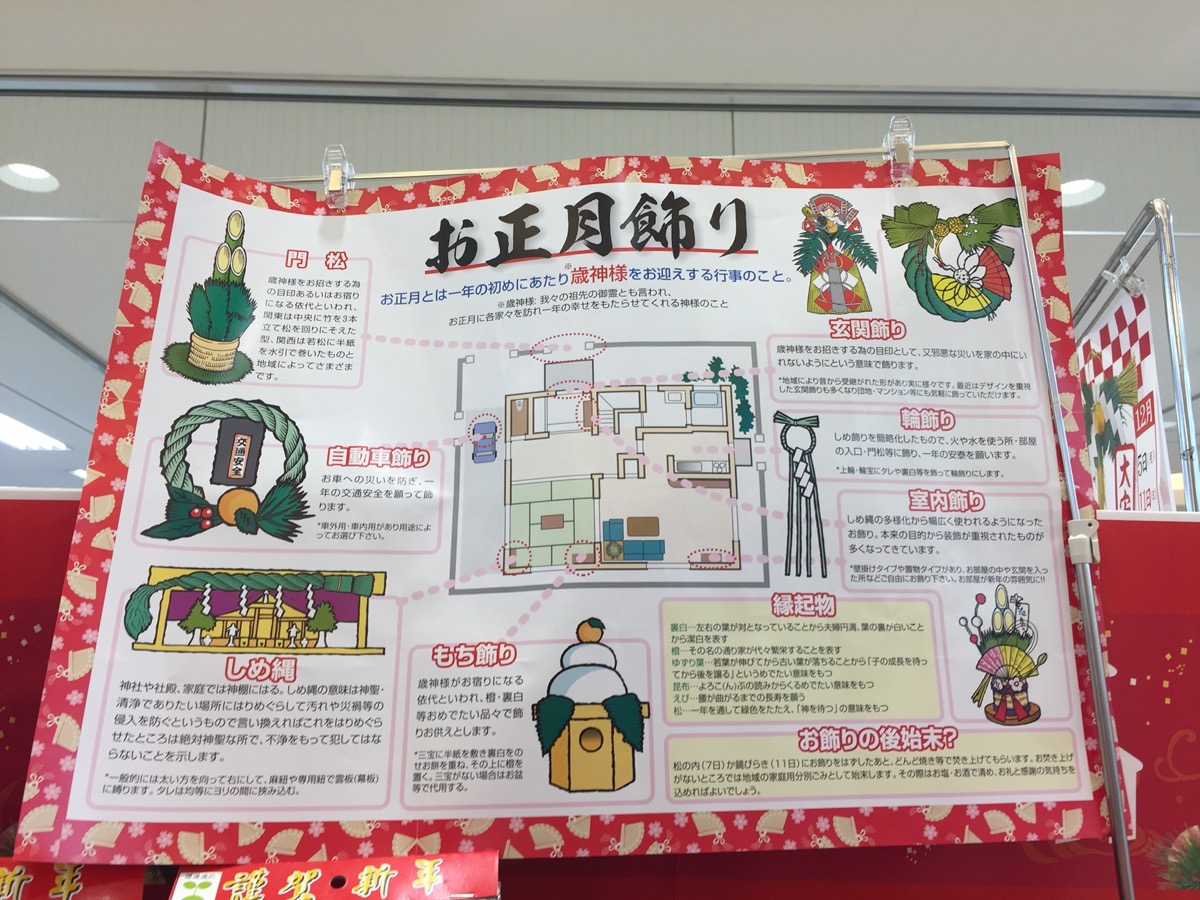
As I was shopping in SanA (grocery store), they had a nice poster (shown above) of where to put all the New Years decoration (in Japanese, but nice nonetheless). Right now there are tons of different pieces that one can purchase to get the house ready for the New Year. Some of the common decor and traditions you will see in Okinawa:
shimekazari しめ飾り: a rice straw rope wreath しめ縄 (shimenawa) with white paper 紙垂 (shide). In Okinawa, it is common to have a fairly simple straw “wreath” with a piece of charcoal wrapped in konbu 昆布 (seaweed) and an orange (mikan みかん) attached, though plenty of people also buy the fancier ones. You can even buy ones with Rilakkuma and other characters on it. This kind of thing can be placed on your door, or above the entrance to your house. It is to purify/protect the house. A more simple shimenawa rope is often placed above the family butsudan 仏壇 (altar). Some people even buy small ones and put them on their cars. I buy new ones every year, but I have heard people admit they reuse them for a few years (instead of burning it on the ritual day) and just add a fresh orange/charcoal. So again, if you buy a nice one that is too pretty (or expensive) to burn… don’t feel guilty for not burning it according to tradition.
kadomatsu 門松: 3 pieces of bamboo with pine are arranged on a circular base. Also typically placed at the entranceway, to welcome the toshigami 年神 (year deity/god) to the house (they can land on the bamboo posts). I have a (plastic-y) set that I reuse. Sometimes it is nice to buy fresh new ones, but the New Year adds up quickly. Again… you can buy them and burn them in the ritual… but don’t let anyone make you feel bad for being a little frugal. Japanese people are like this too.
minori 稔り: this is rice straw tied in a bunch. Can be placed by the altar/butsudan, but I think some people in Okinawa use these instead of kadomatsu at the front entrance. Some people may even braid their own shimekazari from these.
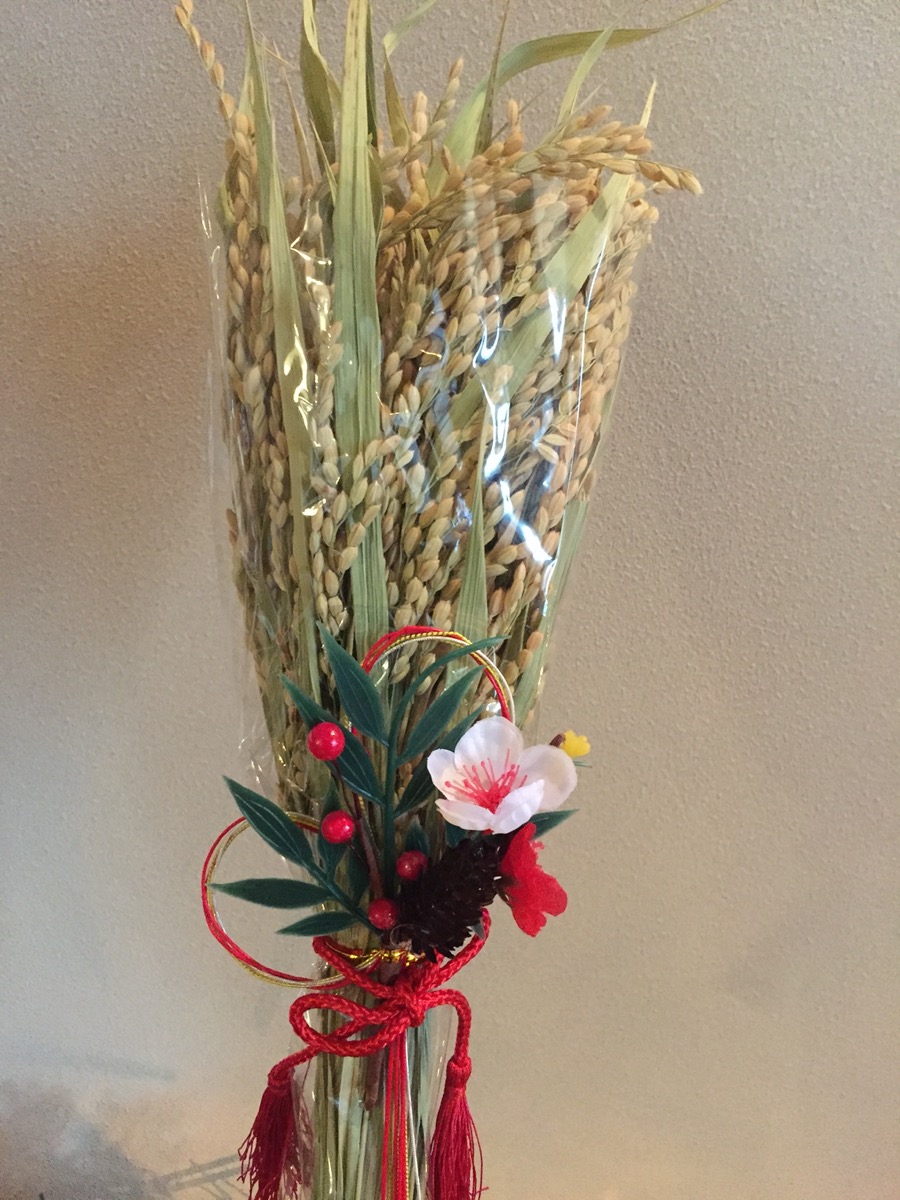
kagami-mochi 鏡餅: this is “mirror” mochi. I cannot tell you the number of Americans who buy one, open it, and BITE into it raw! Then they wonder why Japanese eat wax. But no… you must heat up the dried mochi! Anyway, these are stacked pieces of dried mochi with a New Year decoration (like an orange or zodiac symbol on top). This is usually placed at the butsudan /altar or kamidana 神棚. You are not supposed to open it and “break” the mirror (crack the mochi into pieces) until on Jan 11th (some regions might do different days). Anyway, on kagami biraki 鏡開き (break the mirror ceremony), open up your dried mochi that you bought and break it into pieces (you should not use a knife but mallet or something instead, but I won’t judge you if you decide knife is easier). You can heat it up a number of ways. My favorite is toast it in the microwave or toaster oven or even a grill (just a little until you see it puff up and brown), then add it to hot zenzai ぜんざい (red bean soup, you can make yourself or just buy the prepared package at SanA). Yum! You could also check online for some ozoni soup recipes お雑煮.
charcoal wrapped in kelp: 炭= charcoal, so sumi-kazari 炭飾り is charcoal decoration. In Okinawa, charcoal is very important for purification, health, and for longevity (since it does not “decay”). Pieces of charcoal wrapped in kelp and with auspicious kanji/ribbon are placed not only on the shimekazari, but also on the butsudan (altar) or the hinukan 火の神.
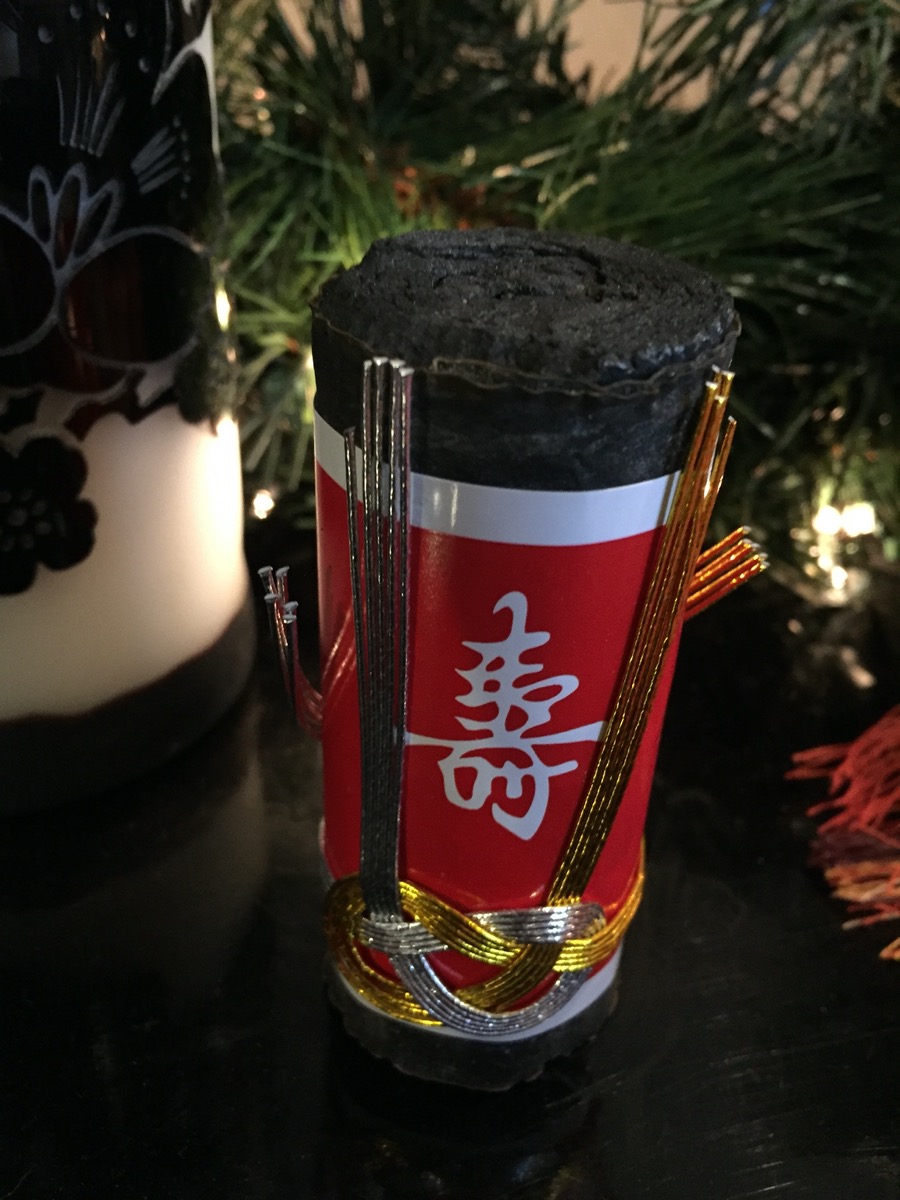
figurine of New Year zodiac animal: This year is year of the rooster and last year was year of the monkey. In recent years I have started getting the cheap Hello Kitty zodiac figurine. It is cute although I suppose not so traditional. Only 500yen at Tokyu Hands.
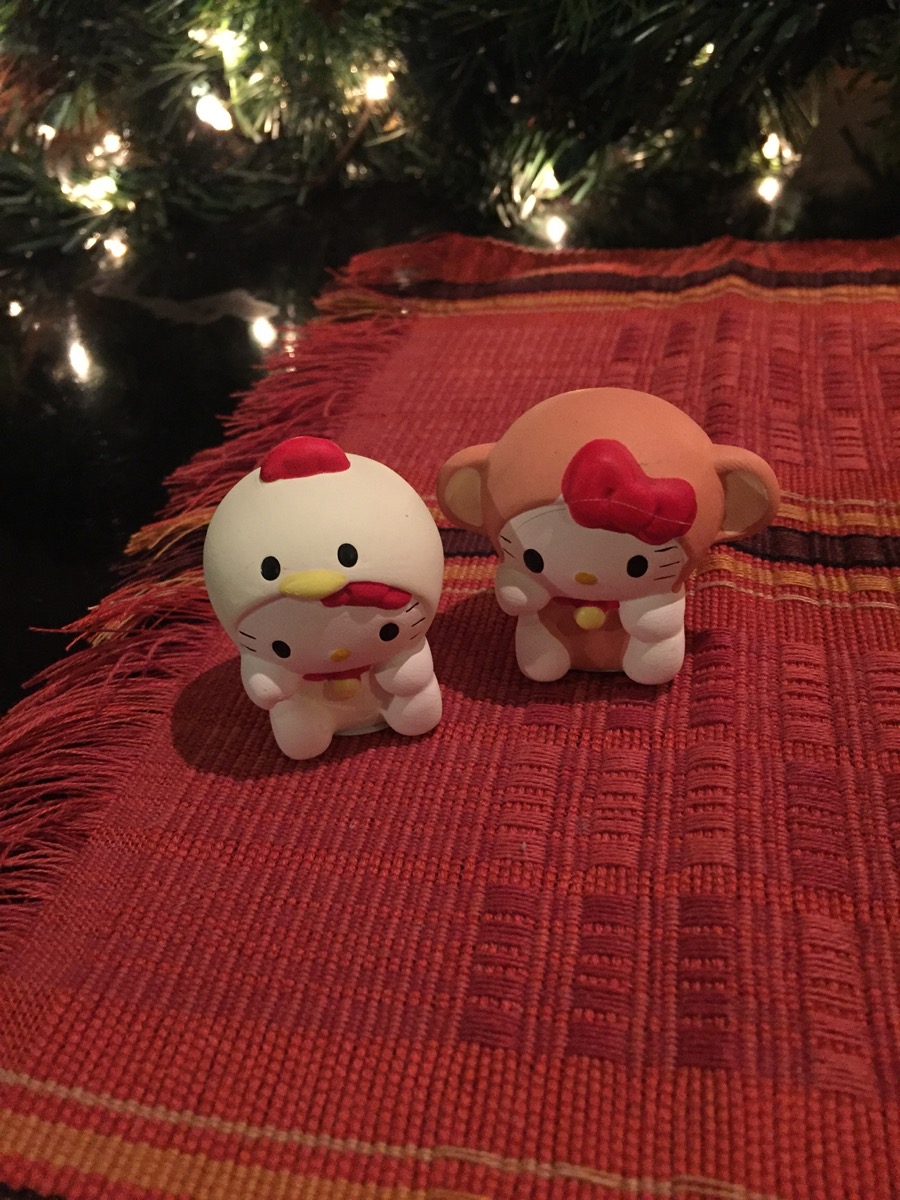
Many New Years flower arrangements will have plum blossoms, pine, bamboo, cabbage and other plants that have special symbolism for spring or the beginning of a new year.
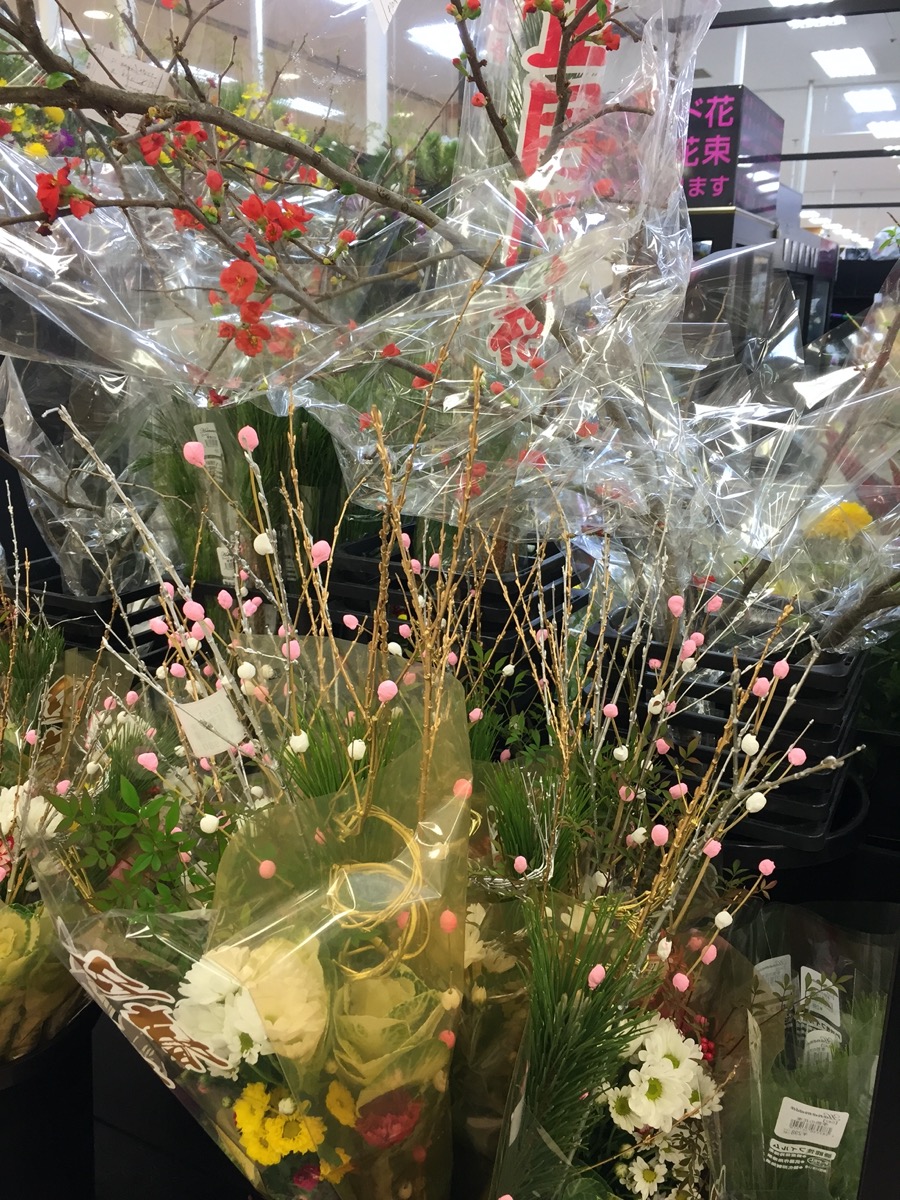
otoshidama お年玉: who doesn’t love to receive an envelope full of money? Usually this is for kids to receive. Even as a school teacher in Hawai’i I observed this custom on a small scale during the lunar New Year, and gave kids otoshidama envelopes (called pochi bukuro ポチ袋) with a chocolate coin it– no money, but a little piece of chocolate, so it was still appreciated.
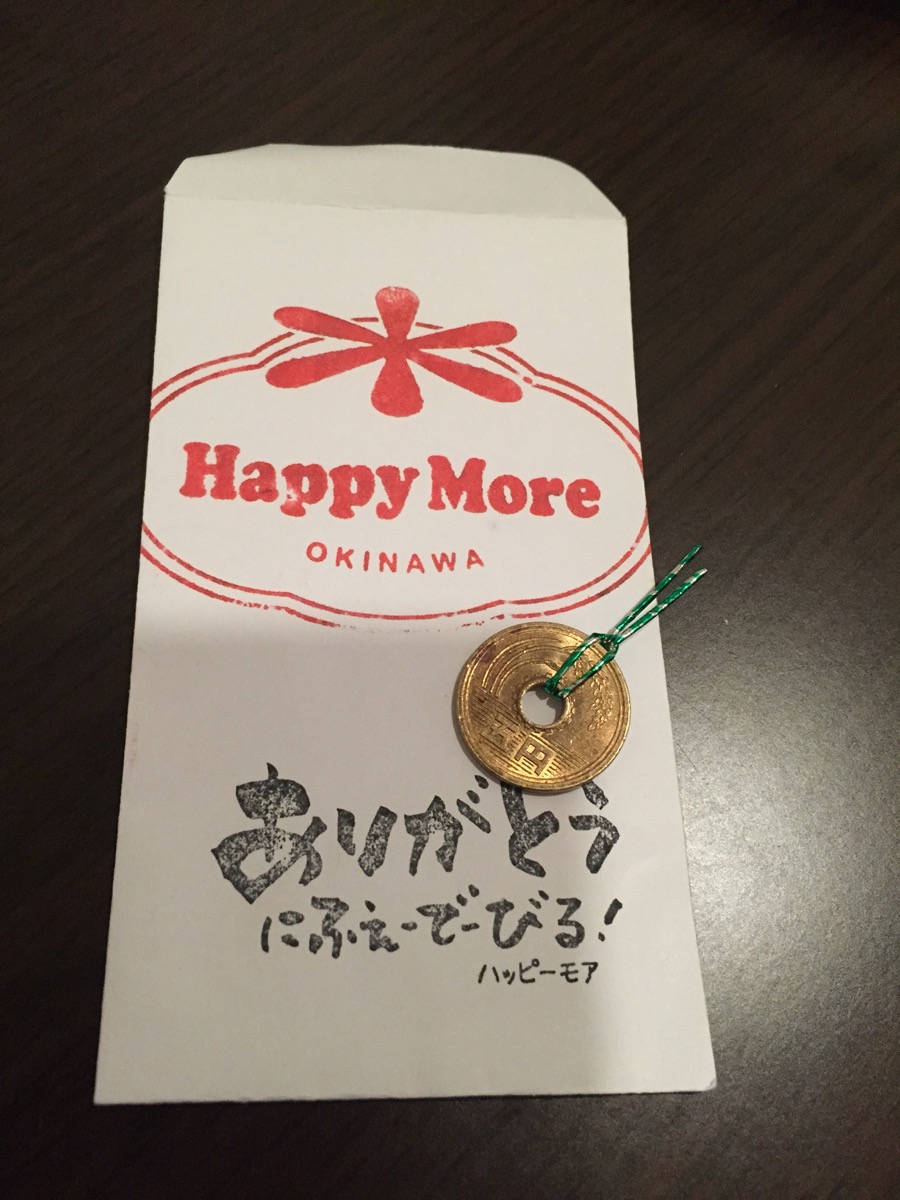
osechi-ryouri 御節料理: Traditional New years food! The best part, amirite? In this modern day you will see stores bustling with pre-orders, not many people have so much time to prepare all this! Again, it usually falls on the wife of the oldest son to prepare these things (some of the ladies in my eikaiwa say it is best to marry a second son!), similar to Obon, so as you can imagine ordering a platter with all the required items from a restaurant or grocery store is much easier. There are a few traditional foods necessary for Okinawan osechi-ryouri, most of them are fried, some type of pork, or shrimps. Honestly in the stores, the fried foods and Okinawa hors d’oeuvres plates (オードブル) were flying off the shelves while the mainland-style foods were left somewhat untouched. I will try to take a few pictures this year; below are pictured more mainland Japanese types of food for New Years.
toshikoshi soba 年越しそば: year-end soba. On Dec 31st, people eat either mainland Japanese soba or Okinawa soba depending on preference.
nakamijiru 中身汁 (also 中味汁): Nakami-jiru is intestines soup (pork). This is a very traditional dish for Okinawan people, but younger generations are (for perhaps obvious reasons) less inclined to eat it these days. Bags of pre-made soup (just heat and serve) and large bags of “chitlins” (pieces of intestines, pardon the American slang) are easily found in the center aisles of the store this time of year.
Winter gift, oseibo 御歳暮: just like summer gift (chuugen), all the groceries drag out the box gifts. You can buy the same types of item: spam, laundry detergent, beer, rice… and you can have them ship it to relatives afar or just have them wrap it and deliver yourself during the days leading up to the New Year.
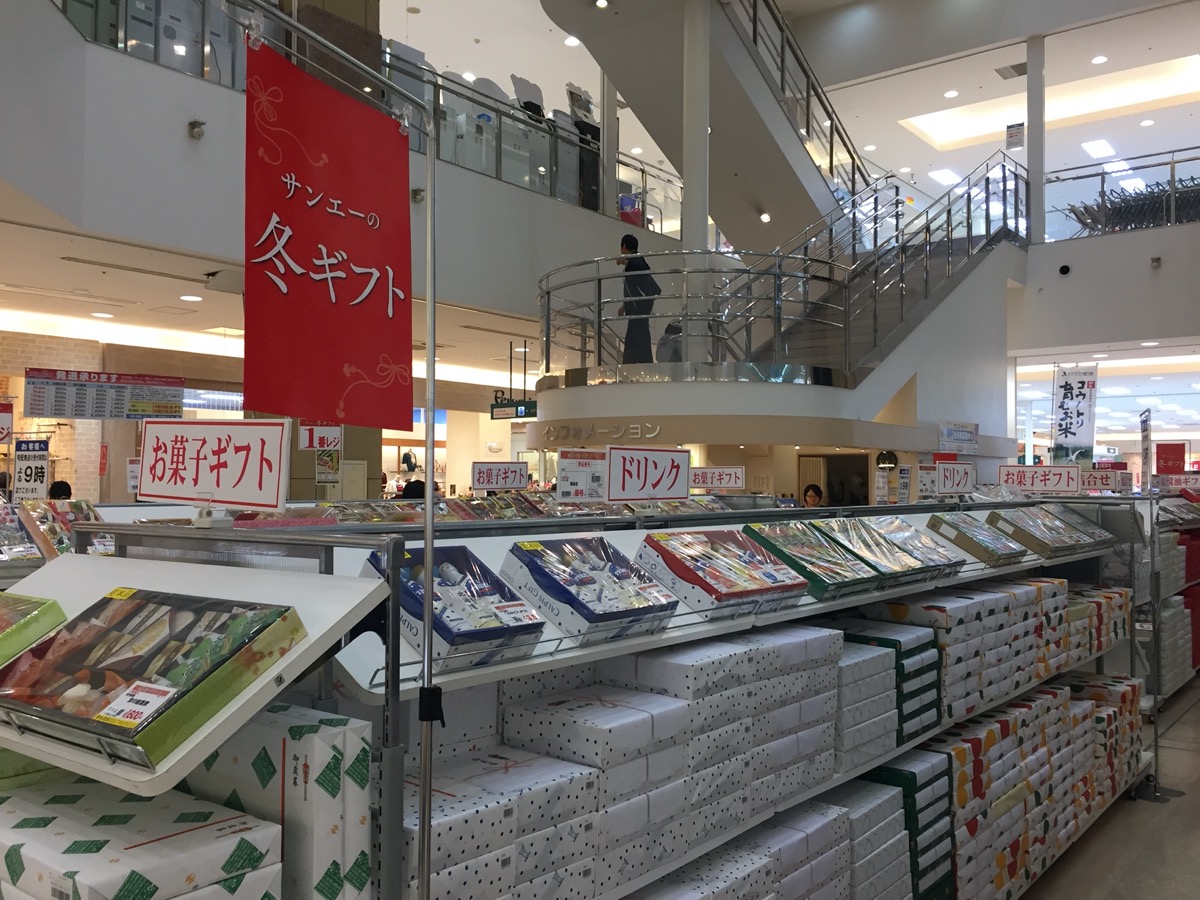
On New Years Eve, we typically watch Kohaku Uta Gassen 紅白歌合戦 (red vs white singing competition) featuring popular music artists and enka singers. Basically it is women (red) vs men (white), and while it is sort of cheesy at times (people complain about the talentless AKB48 groups), it is actually fun to have on while waiting for the end of the year. At the end, the votes are tallied and the winning team determined. Hotaru no hikari 蛍の光 (to the tune of Auld Lang Syne) is sung at the end, and then the program flashes to celebrations at New Years temples and shrines around Japan.
On the first of January, the Japan Post delivers New Years Cards with lottery numbers printed on them; see a related post on New Years Cards 年賀状 called nengajo 年賀状.
During the first week of New Years, especially on January 1st is the custom of hatsumode 初詣, the first visit to a shrine or temple (click here for info on shrines and temples in Okinawa); at midnight on New years you can usually hear the bells tolling 108 times. This is the time to buy new omamori お守り (protective amulets) and leave the old ones at the shrine or temple for the ritual burning. The shrines and temples are open 24 hours for the first 3 days of the New Year, so you can really go any time!
One tradition that is also very popular here in Okinawa is watching the first sunrise of the New Year, called 初日の出 hatsuhinode. Many people gather on ridges overlooking the east side of the island, and some locations have special events, such as Nakagusuku-jo ruins site. The 東太陽橋 Agai-tidabashi (bridge) by the SanA in Nakagusuku is always very crowded (this is also a popular moon-viewing spot).
And of course, the biggest shopping day of the year to score some good deals and fukubukuro (lucky bags) 福袋.
Some words/phrases you may see (or hear) a lot of:
よいお年を(お迎え下さい) yoi otoshi wo (omukae kudasai): said only before the New Year in December, basically “have a a good New Year.”
明けましておめでとうございます akemashite omedetou gozaimasu: Happy New Year (said after the New Year has begun)
今年もよろしくお願いします kotoshi mo yoroshiku onegaishimasu: Please take care of me (again) this year. Said after the New Year begins.
今年もいろいろお世話になりました kotoshi mo iroiro osewani narimashita: Thank you for everything you have done for me this year. Said before the New Year begins.
また来年も宜しくお願い致します mata rainen mo yoroshiku onegai itashimasu: Next year please also take care of me. Said before the New Year begins.
謹賀新年 kinga shinen: Happy New Year (written, not usually said)
賀正 gashou: Happy New Year (written, not usually said)
迎春 geishun: welcoming spring (again, written not said)
元日 ganjitsu: January 1st
元旦 gantan: The morning of January 1st.
あけおめ ake ome: slang (shortened version) of akemashite omedetou (Happy New Year).
クリスマス kurisumasu: Christmas
The Christmas season in Okinawa can be a pretty fun time of year. Although Christmas is not a public holiday here, nor a traditional holiday, many people still celebrate it in some way. I don’t actually get the day off here– I go to classes or work in the research lab.
Some stores sell a few Christmas decorations and lights, but the prices are much higher than you would expect to see in the US. You will not find a fresh Christmas tree and garland here. You can find, however, small potted “Christmas” trees and poinsettias (and for a good price) at the home stores such as Makeman and Cainz. Your best bet is to check out the Daiso and other 100yen shops for cheap decorations. It won’t be anything fancy, but the price is right. Every year it seems stores are selling more and more Christmas merchandise.
Since decorating homes is neither traditional nor cheap, huge illuminations displays at resorts, malls, gardens or other tourist sites is very popular. There are several places in Okinawa you can enjoy Christmas light displays; some are free (smaller displays) and some are paid (much grander displays). Some places to check out are: Itoman Peace Park, Southeast Botanical gardens, Okinawa Children’s Zoo, Murasaki-mura in Yomitan, Kariyushi resort (up north), Kanucha resort (up north), Naha Ryubo Palette Kumoji, and American Village in Chatan. I probably missed a few, but this is a good start.
Christmas is usually perceived to be more of a “date night” for couples, so many restaurants will offer a price fixe menu (almost everywhere requires reservations in advance!). Keep in mind, the actual day of Christmas is not necessarily known by some Japanese/Okinawans– no seriously, I was asked by quite a few people this year what day Christmas was on, and for how many days it was celebrated. I have a feeling there is some confusion over Christmas eve, Christmas day, and Boxing day (or maybe the whole bit with the 12 days of Christmas). So with this in mind, some places will offer the menu only on Christmas, while others include the 24th, or even the 23rd and 26th.
For those who do not go out on Christmas, it is extremely popular to preorder fried chicken (フライドチキン in katakana) from places such as KFC and Mos Burger, or from the Aeon and SanA grocery stores. You can even preorder from the convenience stores like Lawson or Family Mart. The sign up for time slots to pick-up fried chicken usually starts in late November. Time slots fill up quickly, so do not expect to waltz into KFC on Christmas eve or Christmas day and pick some up. Definitely preorder if you want to partake in this tradition. Usually the grocery stores do not fill up so quickly, and will have extra out on those days, so at least you can find something.
In addition, Christmas cakes (クリスマスケーキ) are popular. Usually this means a strawberry shortcake with whip icing, but recently all sorts of chocolate gateau, yule logs, cheesecakes, or other fancy torte cakes have gained popularity. Almost every single bakery/patisserie has pre-orders for cakes during the season to be picked up from the 23rd through 25th. Again, the grocery stores and conbini you can usually pick up a (small individual) cake on the day of, but other places you will need to place your order 2 weeks or more in advance. The slots of cakes don’t fill up as quickly as fried chicken, except maybe at the most popular bakeries. Honestly, the prices for a whole cake are a bit staggeringly high. This year, I chose an up-and-coming bakery to order from since their price is a bit cheaper than the more established and well-known places. The best part is, since I placed my order before a certain day, I received a 10% discount! So keep in mind if you live in Okinawa and want to get a Christmas cake: order your cake early since many places will give between 5-20% discount for early orders. Even places like Lawson and FamilyMart conbini take advance orders for Christmas cakes as well as fried chicken (1-stop shopping)… further reminding me that convenience stores in Japan truly are convenient, and you can pretty much do anything at these places (pay bills, receive Amazon packages, buy concert tickets and more).
Somewhat strange to me is starting around November, stores will start to put out Christmas decor and play incessant Christmas music (or more likely, muzak…). For a not-very-Japanese holiday, many people really enjoy and get into the spirit of the holiday season.
If you are in Okinawa during the holidays, be sure to enjoy some of these different “traditions”!
メリークリスマス!Merii kurisumasu!
メリークリ merii kuri is the shortened version, and I have actually had this sent to me in text messages from friends to my surprise.
年賀状 nengajo: New Year’s card
It is customary to send out postcards for the New Year (oshougatsu お正月) in Japan. This is really a huge business, similar to Americans sending Christmas cards every year. You write some customary sayings, and perhaps include some news from the year or personal messages.
The post office delivers them on January 1st, as long as you send them in before the deadline (December 25th)! Last year I received a few. Last year was the year of the monkey, here are some examples (I will post new Year of the Rooster after the New Year):
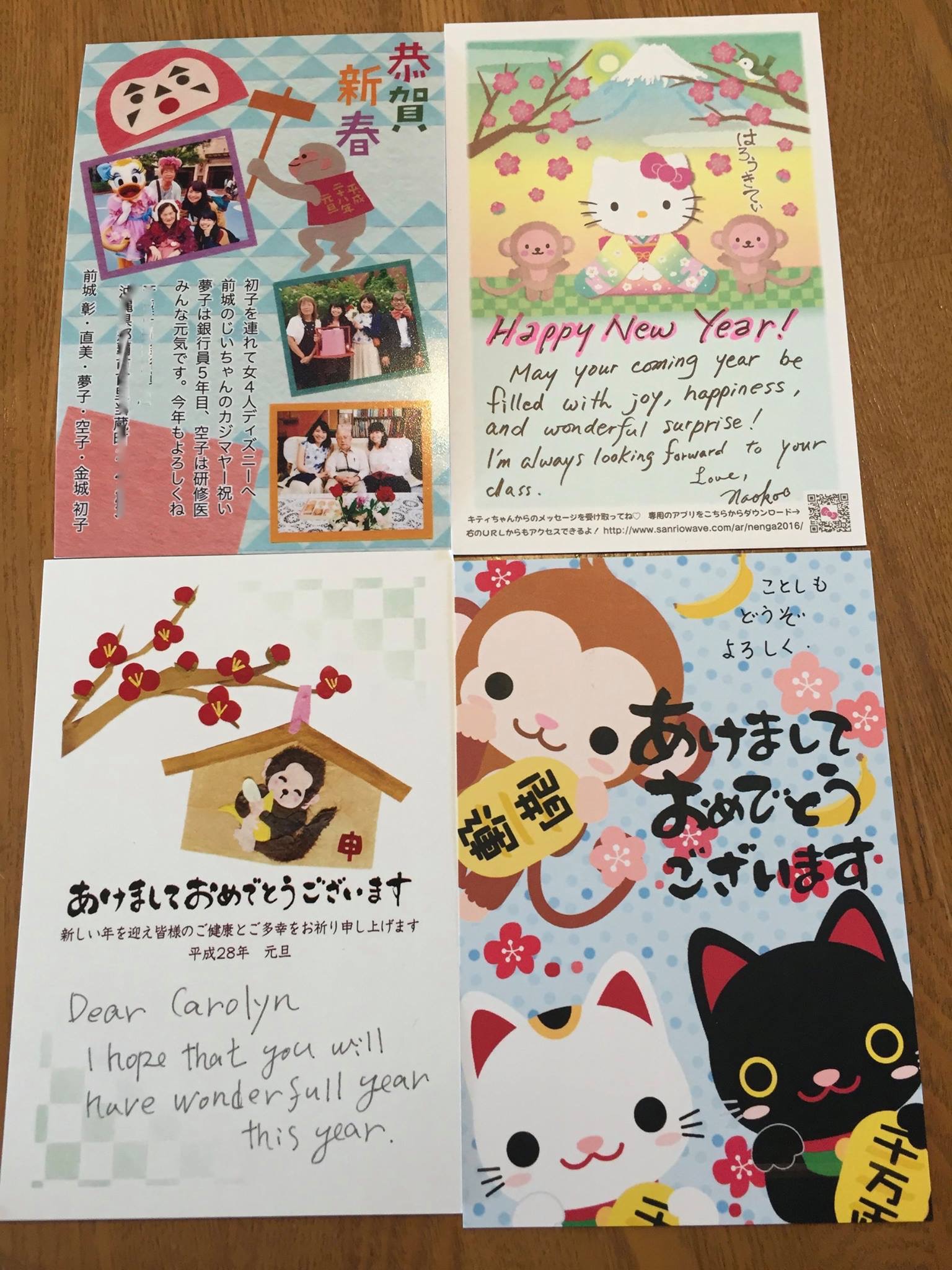
This year, my husband and I custom printed some cards from a popular shop in the SanA mall. We picked a design (not going to lie, it was a Hello Kitty/Year of the Rooster design, and I am not really embarrassed about it despite being a grown married woman) and a picture of us for the front. It is not terribly cheap, but includes the postage. It is rather cute, so I am happy with the result. We will be sending them out to some local friends.
There are not too many rules as to how to write a card, just as long as you can the address on there. The address can even be written in English characters (romaji), or if you want to challenge yourself, write in kanji. Otherwise you can design as you like; the stores are all brimming with ink stamps, stickers, specialized pens and more to design the perfect nengajo! If you google it, you can get all sorts of info on how to send nengajo, but honestly, it is not as complicated as some of them make it out to be– just pick some designs you like, write an appropriate message, and write the address clearly in either Japanese or English. If it does not have postage prepaid on it, go to the post office, the workers will be very helpful; otherwise if the postage is already taken care of, simply drop it in the postbox before December 25th. You can also send them AIRMAIL to other countries, I have sent a few to the US as well for just an additional 18yen per postcard. Again postal workers will be very kind and knowledgeable about this so do not hesitate; on the card in the printed boxes instead of the postal code, just write AIRMAIL, although the postal worker will also affix an Airmail sticker somewhere. It is a good idea to also include your own address at the bottom or front in small print for person receiving the card.
There are some typical phrases you will see on most cards. あけましておめでとうございます akemashite omedetou gozaimasu means “Happy New Year” (well, literally Congratulations on the newly opened year, or something like this). By the way you can only use this AFTER the New Year has begun (so it is okay on nengajo as they are delivered on the first of the new year); if you use it before the New Year, people will give you odd looks. Last year I had heard あけおめ! ake ome! which is a shortened version of this. It was spoken by college age kids to their friends, so remember this may not be the best version to use as a 外国人, though it may elicit some giggles.
Another popular phrase is 今年もよろしくお願いします kotoshi mo yoroshiku onegaishimasu (or some variation of this, ranging on more polite to more casual). It means, Please take care of me again this year.
You will find that the stationary stores are filled with ink stamps, stickers, cards, envelopes, and more for decorating your nengajo. It is almost overwhelming, and so many of them are cute… I have to restrain myself every year.
Nengajo with lottery numbers for the New Year Jumbo Lottery are issued by the Japan Post and usually printed on the bottom of the card. Prizes are announced on January 15th and are household objects or local products. I have never won anything… but then again I have not received so many cards, so my odds are probably pretty low.
It’s that time of year again… bonenkai season!
忘年会 bonenkai (or bounenkai) is an end-of-the-year party or gathering; these are for social clubs, coworkers, old classmates, friends, family… everyone! And often you may have a few to attend. I have currently already committed to some myself.
The first kanji 忘 means “to forget”, 年 mean “year,” and 会 means “gathering” or “meeting.” Basically, it means a forget-the-year-party! As it was explained to me by an older Okinawan, his feeling was that the deeper meaning meant to forget the bad things that happened over the past year, as well as the good things, since there is no promise for the future– the next year is a clean slate and a chance to start anew. I never thought of it that way until I heard that, but it actually does make quite a bit of sense; I think I assumed it mostly referred to only forgetting the bad (and imbibing as much alcohol as possible in order to do so, and possibly forgetting your senses as well).
Bonenkai is a type of nomikai 飲み会 which just means “drinking party.” There is also a shinnenkai 新年会, first gathering after the New Years as well; sort of like bonenkai, part II, but this time celebrating the beginning of a fresh new year.
Anyway, typically everyone agrees on a day/time and whoever is “leader” will make reservations at an izakaya 居酒屋 (or some other type of place with food and drinks). It is popular to have an enkai 宴会 option (banquet plan, party plan), so everyone just pays a set fee; obviously it is also typical to also include a nomihoudai 飲み放題 plan (all you can drink) in addition to the enkai plan for a set fee. It is a fun time with friends, to go out and get ready for the new year with chatting, drinking, and possibly karaoke or other shenanigans. It is something that everyone looks forward to as the year is coming to a close.
I doubt I will include any pictures, as most of them tend to be drunken embarrassment… maybe I will try to take some before everyone has had too much to drink at the next bonenkai I attend.
獅子舞 shishimai is “Lion Dance.”
This obviously has roots in Chinese culture. The shishi dog-lions are similar to shisa dog guardians; they are meant to protect or ward from evil, and to bring prosperity. Okinawa lion-dogs have hairy bodies, unlike the mainland, and lacquered heads made from the wood of Diego trees. Each region is a bit different in style, as well as dancing.
Shishimai are popular during traditional celebratory events, such as the New Year and Harvest festival (豊年祭 hounen-matsuri, around juugoya). Ryukuan lion dance is bit different from the Chinese style; less acrobatic, and usually larger or bulkier. There is a “handler” that sort of leads them around as they perform.
This is a terrible picture… hopefully I can get some better ones this year. This is the style of shishi lion in my village; he has a green lacquer face and and brown dreads.
